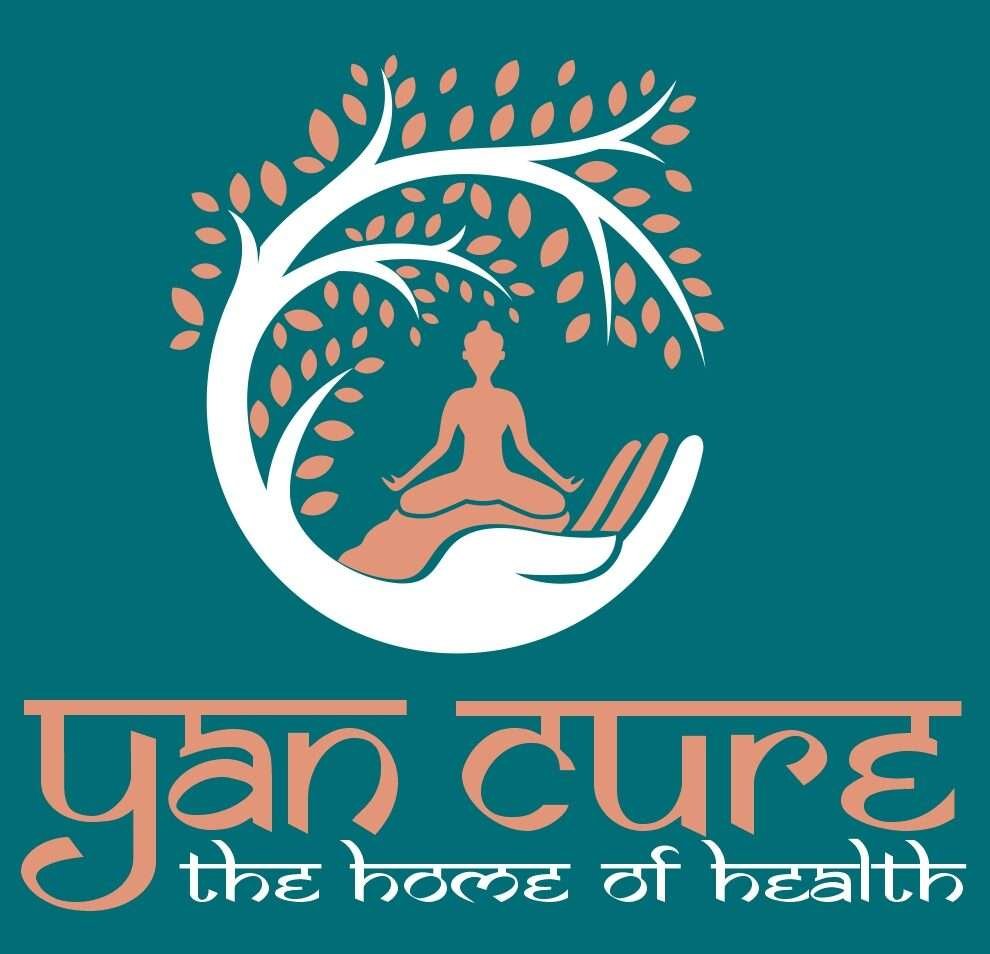Call Us
+91 9811002040
Traditional Therapies
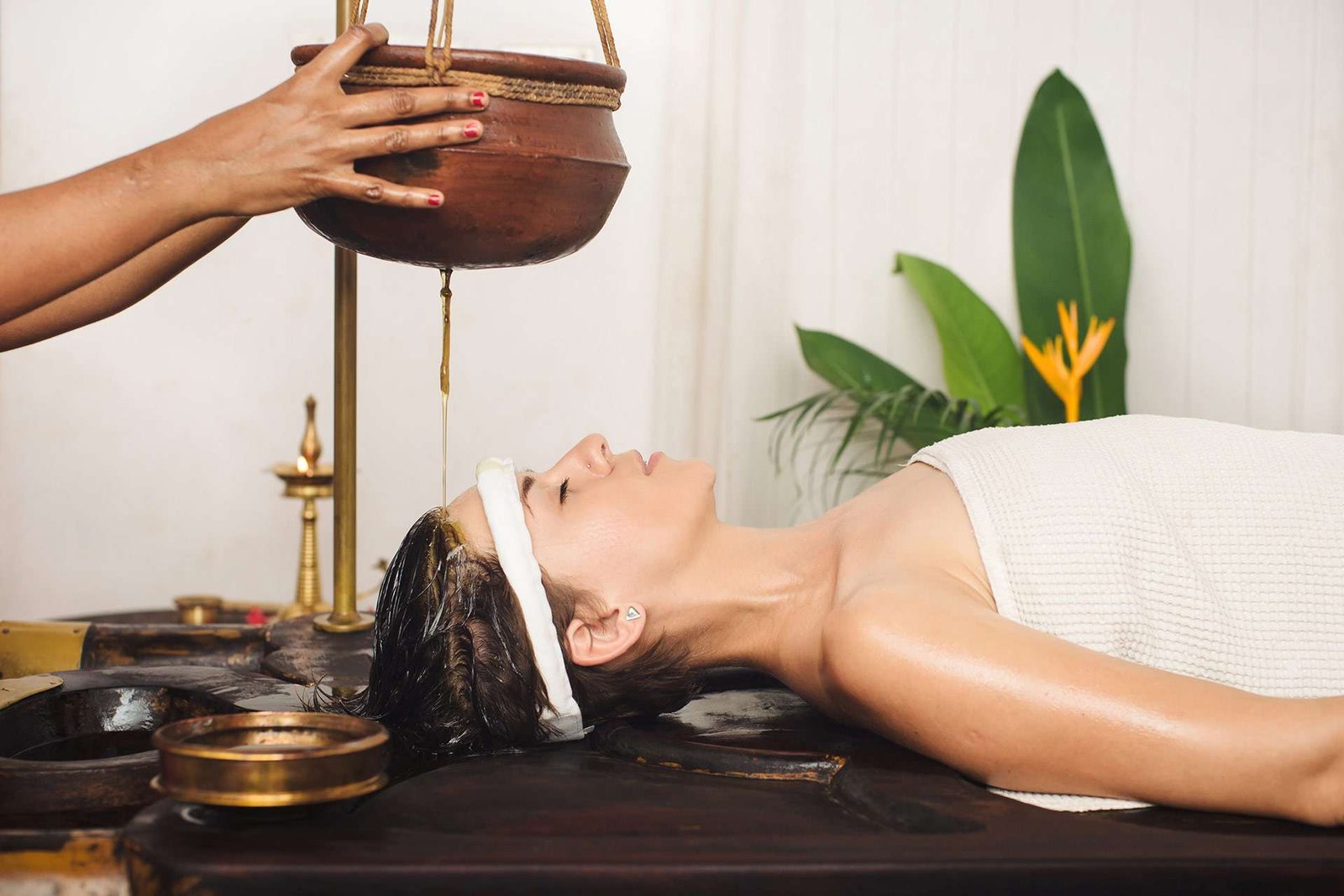
Traditional/Alternative Therapies
Traditional and alternative therapies encompass a diverse range of healing practices that extend beyond conventional Western medicine. Traditional therapies often draw from centuries-old cultural and indigenous knowledge, while alternative therapies may include non-mainstream approaches gaining popularity in contemporary settings. Traditional therapies often involve practices deeply rooted in cultural and historical contexts. Examples include Traditional Chinese Medicine (TCM), Ayurveda from India, and Native American healing traditions. These approaches typically focus on restoring balance within the body, mind, and spirit through techniques such as herbal medicine, acupuncture, massage, and energy balancing.
Alternative therapies, on the other hand, encompass a broad spectrum of approaches that may not be widely accepted in mainstream medicine. Examples include homeopathy, naturopathy, chiropractic care, and mind-body interventions like meditation and yoga. These therapies often emphasize holistic well-being and may prioritize natural remedies or lifestyle changes to support the body’s innate healing abilities. Both traditional and alternative therapies share a common principle: treating the individual as a whole, addressing the root causes of illness rather than merely alleviating symptoms. While traditional therapies have often stood the test of time within specific cultural contexts, alternative therapies may challenge established medical norms, sparking ongoing debates about their efficacy and safety.
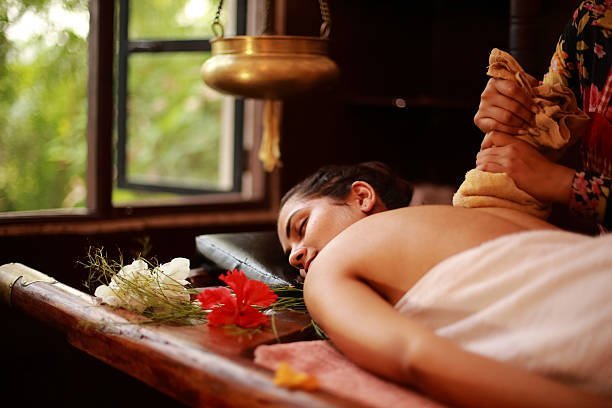
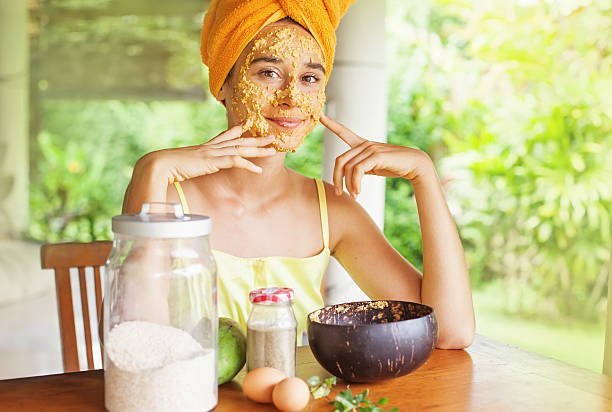
In recent years, an integrative approach to healthcare has emerged, combining elements of both traditional and alternative therapies with conventional medicine. This integrative approach recognizes the value of diverse healing modalities and seeks to provide patients with a more comprehensive and personalized approach to health and wellness. As individuals increasingly explore diverse options for their well-being, the collaboration between traditional, alternative, and conventional therapies continues to evolve.
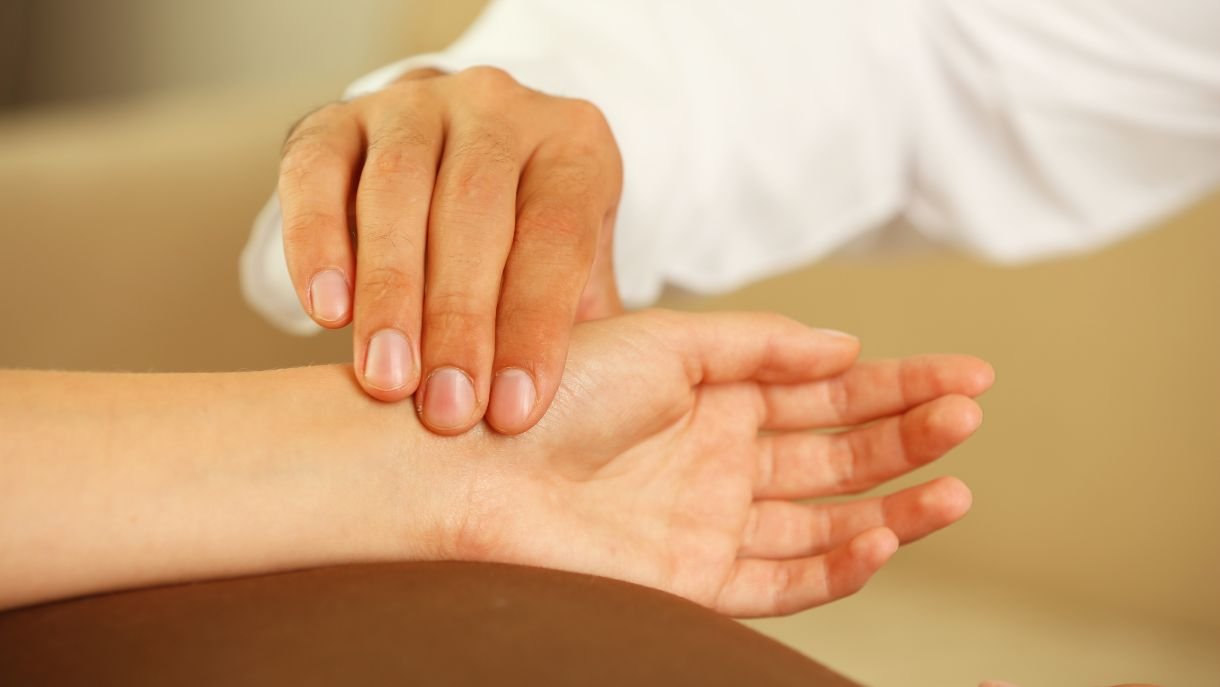
Ayurvedic Doctor Consultation
Health conditions can be dealt effectively, only if properly diagnosed. No two person’s diseases or symptoms can be alike. Therefore, in Ayurveda we look every individual as unique. Ayurveda programs have to be specially designed to help an individual’s health conditions. No single program can be a help for everyone.
As the healing approach in Ayurveda is strictly individualistic, the healing of the mind/body problems varies from person to person. Hence along with the disease, the individual also should be thoroughly assessed.
We offer comprehensive Ayurvedic Personal Consultations with our highly qualified Ayurvedic Practitioners prior to any treatment.
On Arrival:
When you arrive for the first time at Yan Cure, we offer a complimentary herbal/ayurvedic tea of your choice and a consultation form to fill which includes:
- Your personal details
- Current medical illness
- Past medical illness
- Any allergies (Food, Drugs, Environmental etc)
- Any Medications
- Family medical history
- Any recent operations or accidents
- Any history of depression or severe trauma (physical or emotional)
- Current lifestyle and daily routines
- Current diet and eating habits
- Relationships
- Menstrual cycles and pregnancies (if female).
If you are not really sure why you have come (it does happen sometimes!), or don’t have any particular concerns, don’t worry, as after your consultation, we can guide your body’s specific needs.
Once you have completed the form, our Ayurvedic Doctor will do your Ayurvedic Assessment which includes:
- Pulse analysis (Nadi pareeksha) to assess the rhythm, movement and strength of your pulse. This gives us an intricate view of your energy, dosha balance/imbalance and the type of doshas (body type) involved.
- Tongue analysis, this will give us the information on the absorption of iron, about your digestion, general metabolism, and the accumulation of various types of ama (toxins, waste products) in your system.
- Your eyes are checked to see their colour, shape, movement and shine.
- Your skin surface is felt to assess whether it is soft/dry, rough/smooth, cold/warm, clammy/moist or oily
- Your breathing is observed; this will give us the information on your stress levels.
- Your chakras and aura are assessed to find out your physical, mental, and emotional interactions because they are the openings for life energy.
- Assessment of your energy blockage, health issues, current imbalances (physical or emotional).
- Your Prakruti(Your Unique Body Type) : This will be Vata, Pitta, Kapha or any combination of the doshas.
- Your Vikruti(current doshic imbalance) : Understanding of your mind-body type helps us to understand who you are and your uniqueness and helps the practitioners to make a plan that is most personalized for the unique ‘YOU’.
- You will have a better picture of your body types and current imbalances (physical, mental, spiritual and emotional).
- Advice on your personal diet, daily routines, seasonal regimens and Ayurveda Health Food Supplements.
- Advice on yoga poses, exercise, meditation, and pranayama breath practices.
- Advice on healthier life style.
- Detoxification and healing therapies recommendations which may include: Chakra balancing massage, Kundalini awakening massage, distress therapy or Panchakarma detoxification.
- When you leave us, you can also expect a consultation report via email with recommended follow up Ayurveda-Yoga Program within 7 days.
- Depending on your particular health conditions, you may be advised to have a follow up consultation in the future around 12 weeks or six months after your initial consultation or after the completion of a recommended course of Ayurveda-Yoga program.
- Your progress will be reviewed and further advice given based on this assessment.
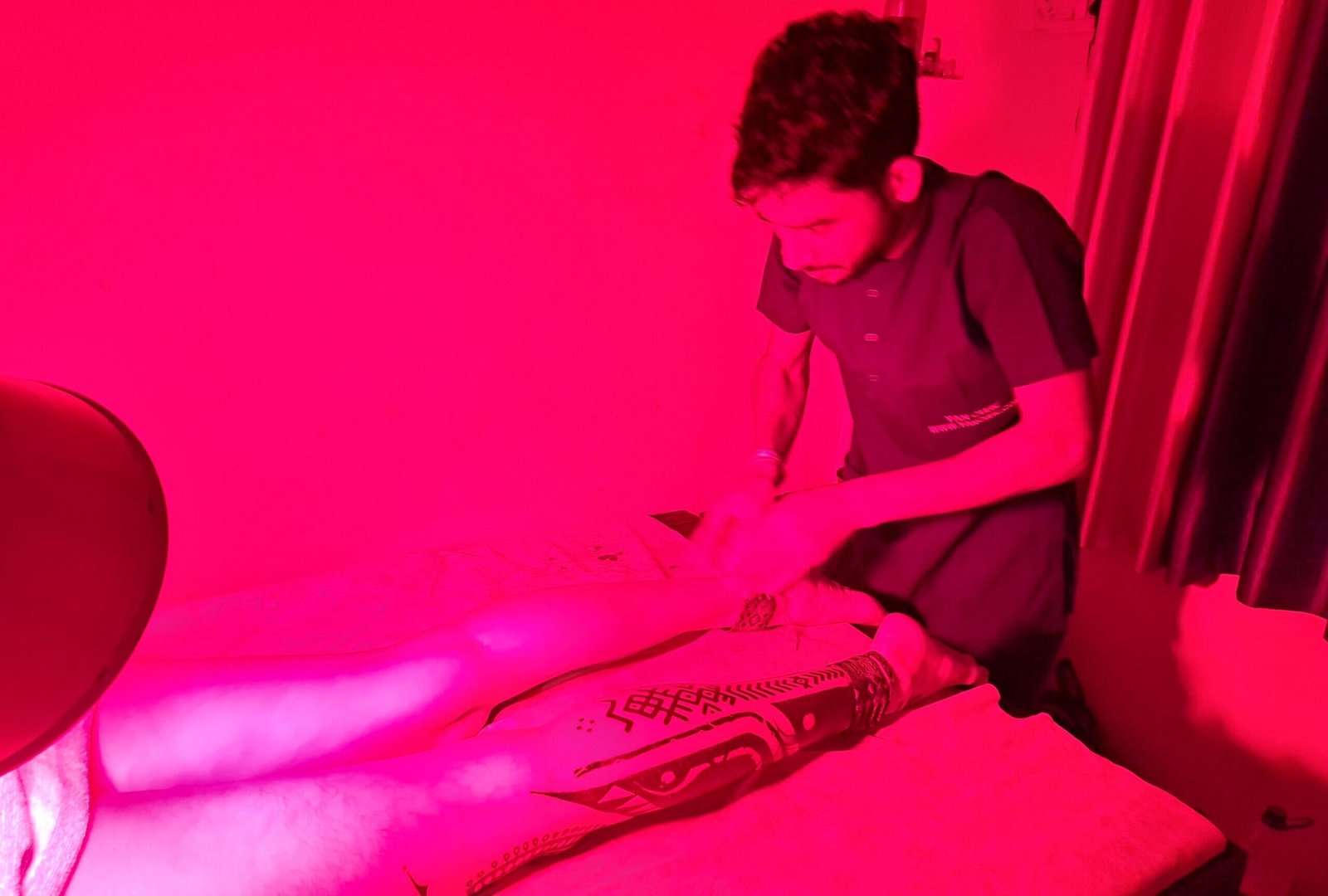
Infra-red Therapy
Infrared therapy utilizes infrared light to penetrate and heat the body’s tissues, promoting various health benefits. This non-invasive treatment is known to alleviate pain, improve circulation, reduce inflammation, and enhance relaxation. It is commonly used in medical and wellness settings to support healing and well-being.
Infrared therapy can help relieve pain and inflammation in your body. Since it can penetrate through your skin, it can get right to your muscles and other tissues. The treatment can improve your circulation, meaning that oxygen will be brought to the recovering parts of your body.
Reduces skin and tissue inflammation and speeds up healing of lesions and wounds. Stimulates collagen and elastin production for firmer, suppler, younger-looking skin. Boosts blood circulation and cellular oxygenation, stimulating a release of toxic wastes for a healthy, radiant glow.
Infrared therapy, also known as infrared light therapy or IR therapy, involves the use of infrared light to provide therapeutic benefits to the human body. This form of therapy utilizes infrared wavelengths, which are part of the electromagnetic spectrum, lying between visible light and microwaves. Unlike visible light, infrared light is not visible to the human eye but can be felt in the form of heat.
The therapeutic effects of infrared therapy stem from its ability to penetrate deep into body tissues, promoting various physiological responses. This penetration generates heat, which can help relax muscles, improve circulation, and alleviate pain. Infrared therapy is commonly administered through devices such as infrared lamps, heating pads, or saunas.
One significant application of infrared therapy is in pain management. The heat generated by the infrared light can help reduce muscle stiffness and joint pain, making it beneficial for conditions like arthritis and muscle injuries. Additionally, the increased blood flow induced by infrared therapy contributes to the body’s natural healing processes.
Moreover, infrared therapy has been explored for its potential to enhance skin health, stimulate collagen production, and even improve cardiovascular function. As a non-invasive and drug-free treatment option, it has gained popularity in various wellness and medical settings. However, it is important to consult with healthcare professionals before incorporating infrared therapy into a treatment plan, especially for individuals with specific health conditions.
- Improve wound healing.
- Reduce stretch marks
- Reduce wrinkles, fine lines and age spots.
- Improve facial texture.
- Improve psoriasis, rosacea and eczema.
- Improve scars.
- Improve sun-damaged skin.
- Improve hair growth in people with androgenic
alopecia. - Improve acne
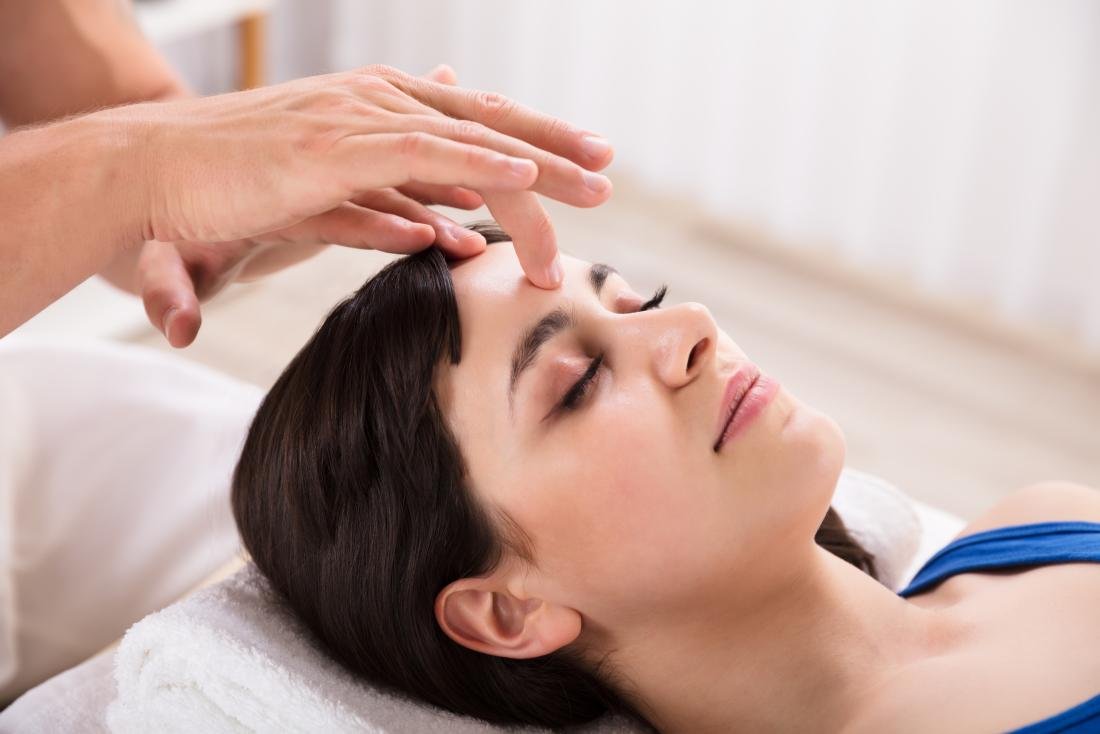
Accupressure Therapy
Acupressure therapy involves applying pressure to specific points on the body to promote relaxation, alleviate pain, and enhance overall well-being. Rooted in traditional Chinese medicine, it aims to balance the body’s vital energy (Qi) by stimulating meridian points, fostering improved circulation, and relieving tension.
Acupressure therapy is an ancient healing technique rooted in traditional Chinese medicine that involves applying pressure to specific points on the body to promote relaxation, alleviate pain, and enhance overall well-being. This practice is based on the concept that the body contains vital energy, known as “qi” or “chi,” which flows along meridians or pathways. When there is an imbalance or blockage in the flow of this energy, it can result in various physical or emotional ailments.
Acupressure utilizes finger pressure, thumbs, or specialized tools to stimulate acupoints, which are specific points along the body’s meridians. The pressure applied is intended to release tension, improve circulation, and encourage the body’s natural healing processes. Practitioners target acupoints related to the specific condition or symptom being addressed.
This therapy has been found effective in relieving a variety of conditions, including headaches, stress, nausea, and musculoskeletal pain. It is non-invasive, drug-free, and can be easily practiced as self-care or administered by trained professionals. Acupressure is often used in conjunction with other complementary therapies and can be a valuable component of integrative healthcare.
While acupressure is generally considered safe, it is essential to consult with a qualified healthcare professional before starting any alternative therapy, especially for individuals with pre-existing health conditions. Overall, acupressure therapy offers a holistic approach to health and well-being by harmonizing the body’s energy flow and promoting a balanced state of being.
- Induces relaxation and restores balance
- Stimulates the circulatory and lymphatic system
- The therapeutic touch stimulates certain chemicals in the brain that boost the immune system, lifts depression and relieves stress
- Acupressure is very safe & Natural method with no side effect.

Acupuncture Therapy
Acupuncture therapy is a traditional Chinese medicine technique involving the insertion of thin needles into specific points on the body to promote balance and stimulate natural healing. It is believed to regulate the flow of vital energy (qi) and alleviate various conditions, including pain, stress, and illness.
Chinese Acupuncture works by using fine needles painlessly applied to specific points around the body to stimulate channels of energy flow allowing the body to balance itself.
Acupuncture therapy is a traditional Chinese medical practice that involves the insertion of thin needles into specific points on the body to stimulate and balance the flow of vital energy, known as Qi (pronounced “chee”). This therapeutic technique is based on the concept of meridians, which are energy pathways that connect various organs and tissues throughout the body.
Acupuncture aims to restore the proper flow of Qi, addressing imbalances that may lead to illness or discomfort. Practitioners believe that by inserting needles at precise acupoints, they can regulate the energy flow and promote the body’s natural healing processes. These acupoints are often located along meridians and correspond to specific organs or functions.
The needles used in acupuncture are typically hair-thin and are inserted into the skin at varying depths, depending on the condition being treated. The procedure is generally painless, and patients often report a sense of relaxation during and after the session.
Research suggests that acupuncture may have several therapeutic benefits, such as pain relief, stress reduction, and improvement in various health conditions. Some theories propose that acupuncture stimulates the release of endorphins, the body’s natural painkillers, and may also affect neurotransmitters and inflammatory markers.
While acupuncture has gained recognition in both Eastern and Western medicine, it is essential to note that its effectiveness can vary among individuals and conditions. Many people find relief from a range of ailments through acupuncture, and it is often used as a complementary therapy alongside conventional medical treatments. As with any medical intervention, consulting with a qualified and trained practitioner is crucial for safe and effective acupuncture therapy.
- Analgesic : – Pain relieving, Achieved by raising pain threshold helpful in case of arthritis, headache, low backache.
- Sedation : – These effect utilized in the treatment of Insomnia, anxiety, addiction, epilepsy & mental disorder.
Homeostatic or - Regulatory effect : – Adjustment of internal environment of body towards a state of normal balance.
- Immune Enhancing : – Where by body resistance to disease is strengthened

Gosha Moksha
“Gosha Moksha” is a term in Hindu philosophy that refers to the ultimate liberation or salvation of the individual soul, achieving union with the divine. It signifies the release from the cycle of reincarnation and the attainment of spiritual liberation, breaking free from the material world.
Moksha Therapy is an ancient and traditional healing practice that has been used for centuries in India, China, Egypt, and Japan. This therapy focuses on enhancing the body’s natural healing response by increasing blood circulation, thereby alleviating pain and inflammation, strengthening the body, and providing energy to the muscles. It also helps in releasing muscle tension and eliminating stiffness, thereby enhancing the efficiency of the body.
Some of the key benefits of Moksha Therapy include :
- Improves Sleep Quality: Moksha Therapy aids in promoting relaxation and can lead to improved sleep quality.
- Reduces Mental Stress: The therapy can help in reducing mental stress and promoting a sense of calm and well-being.
- Prevents Heel Cracking: Moksha Therapy is also effective in preventing heel cracking and promoting healthy skin on the feet.
- Tan Care: It assists in taking care of the skin and maintaining an even skin tone.
- Prevents Greying of Hair: Moksha Therapy is believed to help in preventing premature greying of hair.
- Improves Digestion: This therapy can also contribute to improving digestion and overall gut health.
Overall, Moksha Therapy offers a holistic approach to health and well-being, focusing on both physical and mental aspects to promote overall wellness and vitality.
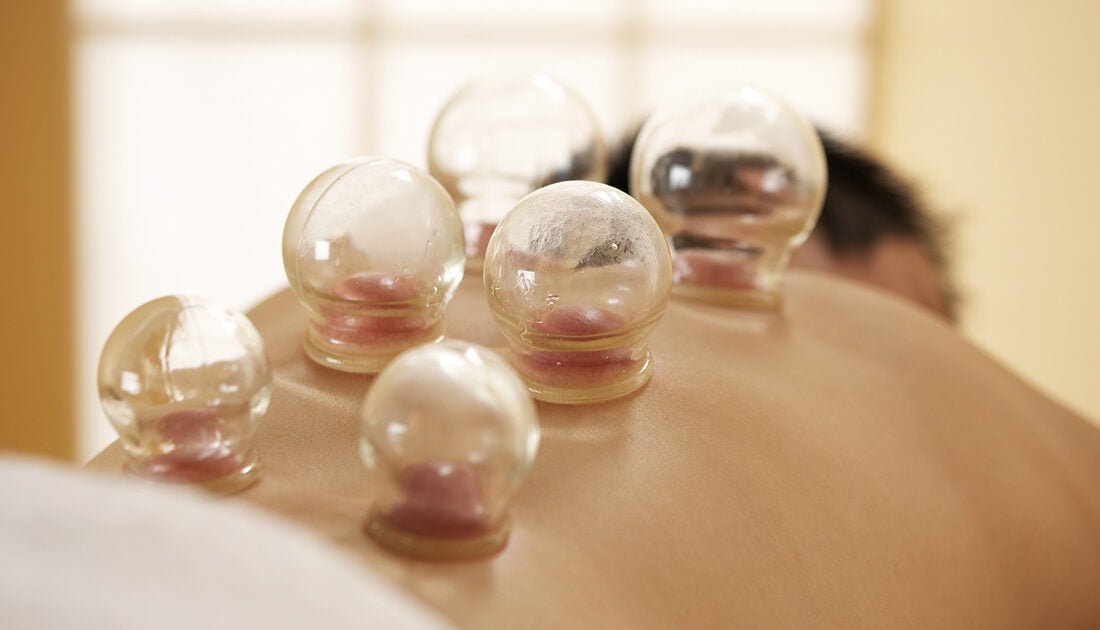
Cupping Therapies
Cupping therapy involves placing cups on the skin to create suction, promoting blood flow and reducing muscle tension. The suction pulls skin and tissues upward, potentially alleviating pain, inflammation, and promoting relaxation. Though popular in traditional medicine, scientific evidence supporting its effectiveness is limited, and it may cause temporary bruising.
Cupping therapy is an ancient alternative healing practice that involves placing cups on the skin to create suction, promoting various health benefits. The technique is rooted in traditional Chinese medicine and has been used in cultures worldwide for centuries. There are two main types of cupping: dry cupping and wet cupping.
Dry cupping involves placing cups on the skin and creating a vacuum by either heating the air inside the cup or using a suction pump. This suction draws the skin and underlying tissues into the cup, promoting increased blood flow and stimulating the flow of energy, known as qi, in traditional Chinese medicine. The cups are typically left in place for a few minutes and may be stationary or moved across the skin in a gliding motion.
Wet cupping, also known as hijama, involves making small incisions on the skin before applying the cups. The suction draws out a small amount of blood, believed by some to remove harmful substances and balance the body’s humors.
Cupping therapy is thought to have several potential benefits, including pain relief, improved circulation, relaxation of muscles and connective tissues, and the release of toxins. While some people find relief from conditions such as musculoskeletal pain and respiratory issues through cupping, its effectiveness is still a subject of ongoing research. It’s important for individuals to consult with qualified practitioners and healthcare professionals before undergoing cupping therapy to ensure its suitability for their specific needs and health conditions.
- Encourage whole-body comfort and relaxation.
- Increase your pain threshold.
- Reduce inflammation.
- Enhance blood circulation.
- Remove toxins from your body.
- Reduce cholesterol and low-density lipoprotein (LDL).
- Help prevent cardiovascular diseases like atherosclerosis.
- Increase red blood cells.
- Wet Cupping
- Vacuum Cupping
- Dry Cupping
- Fire Cupping
- Silicon Cupping

Laughing Therapy
Laughing therapy, or laughter yoga, involves intentional laughter to promote physical and mental well-being. Participants engage in playful exercises that induce laughter, leading to increased oxygen intake and endorphin release. This practice aims to reduce stress, boost mood, and improve overall health through the benefits of laughter.
Laughing therapy, also known as laughter therapy or laughter yoga, is a therapeutic approach that utilizes laughter as a tool to improve physical, mental, and emotional well-being. Rooted in the belief that laughter is a natural and universal human experience, this form of therapy harnesses the positive effects of laughter on the body and mind.
During laughing therapy sessions, participants engage in intentional laughter exercises, often guided by a facilitator. These exercises may include playful activities, group laughter, and simulated laughter, where participants deliberately laugh without relying on external stimuli. The laughter is typically contagious, leading to genuine and spontaneous laughter among participants.
The physiological benefits of laughing therapy are numerous. Laughter stimulates the production of endorphins, the body’s feel-good hormones, which can help alleviate stress and improve mood. It also promotes better circulation, enhances cardiovascular health, and boosts the immune system. Psychologically, laughter therapy can reduce anxiety, elevate mood, and foster a sense of connection and camaraderie among participants.
Moreover, laughing therapy is accessible to people of all ages and fitness levels, making it an inclusive and enjoyable practice. It doesn’t require jokes or humor; instead, it emphasizes the physical act of laughing. As a holistic approach to health and wellness, laughing therapy highlights the importance of laughter as a natural medicine that contributes to a more balanced and joyful life.
Stress Reduction: Laughter triggers the release of endorphins, the body’s natural feel-good chemicals. This can lead to an improved mood and a reduction in stress levels. It also helps lower the levels of cortisol, a stress hormone.
Immune System Boost: Laughter has been linked to an increase in immune system activity. The positive effects on immune function may be due to the release of neuropeptides and increased production of immune cells.
Cardiovascular Health: Laughter can improve blood flow and increase the function of blood vessels, which can contribute to better cardiovascular health. It may also help lower blood pressure.
Muscle Relaxation: The act of laughing engages various muscles in the body, and the subsequent relaxation of these muscles can relieve physical tension and stress.
Pain Management: Laughing can act as a natural painkiller by increasing the body’s production of endorphins. It may help in reducing the perception of pain and improving pain tolerance.
Social Bonding: Laughter is a social activity, and participating in laughter therapy can foster a sense of community and social connection. This can be particularly beneficial for individuals experiencing loneliness or isolation.
Improved Mood: Laughter stimulates the production of serotonin, a neurotransmitter that contributes to feelings of happiness and well-being. Regular laughter therapy sessions may help alleviate symptoms of depression and anxiety.
Enhanced Respiratory Function: Laughter involves deep breathing, and this can improve respiratory function. It can increase lung capacity and oxygenate the body, promoting better overall health.
Improved Cognitive Function: Laughter may have positive effects on cognitive function, including increased creativity, improved problem-solving skills, and enhanced memory.
Mind-Body Connection: Laughing therapy emphasizes the connection between the mind and body. It encourages individuals to be present in the moment, promoting mindfulness and overall mental well-being.
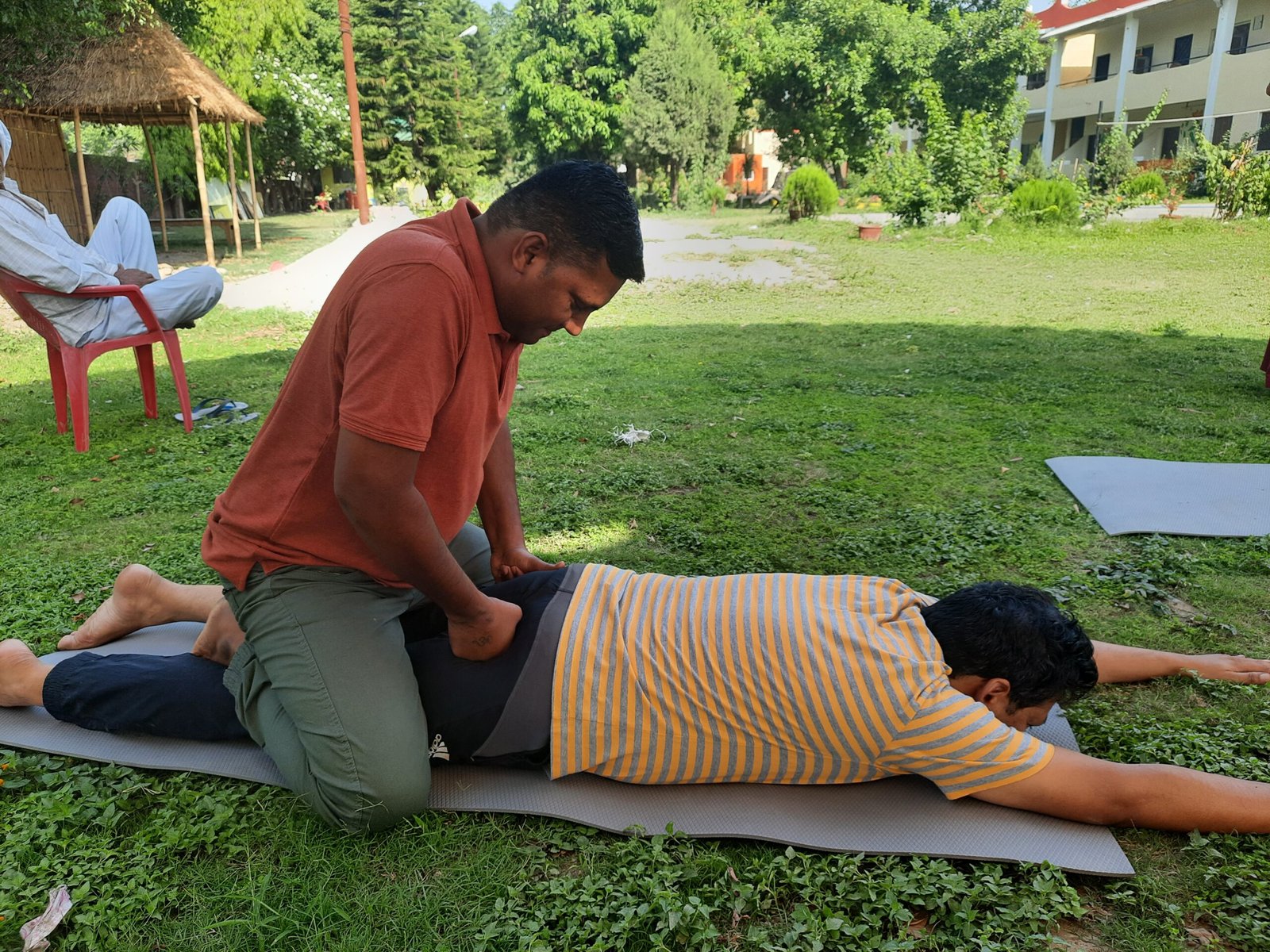
Physiotherapy
Physiotherapy is a healthcare profession that focuses on restoring and maintaining physical function and mobility. Utilizing exercises, manual therapy, and education, physiotherapists help individuals manage pain, recover from injuries, and improve overall well-being. This holistic approach enhances quality of life by addressing musculoskeletal, neurological, and respiratory conditions.
Physiotherapy, also known as physical therapy, is a healthcare profession that focuses on optimizing and restoring physical function and mobility. It employs a holistic approach to address a wide range of conditions, injuries, and disorders that affect the musculoskeletal, neurological, cardiovascular, and respiratory systems. The primary goal of physiotherapy is to enhance the overall quality of life for individuals by promoting physical well-being and functional independence.
Physiotherapists, or physical therapists, are highly trained professionals who assess, diagnose, and treat various issues through a combination of manual therapy, exercise prescription, and patient education. They work with individuals of all ages, from infants to the elderly, and collaborate with other healthcare professionals to create comprehensive treatment plans tailored to each patient’s unique needs.
Common areas of focus in physiotherapy include pain management, rehabilitation after surgery or injury, improvement of joint mobility, muscle strengthening, balance and coordination training, and prevention of future injuries. Physiotherapists may also provide education on ergonomics, posture, and lifestyle modifications to promote long-term well-being.
Physiotherapy is crucial in various settings, including hospitals, clinics, rehabilitation centers, and community health programs. It plays a vital role in helping individuals recover from injuries, surgeries, or chronic conditions, enabling them to regain independence and participate fully in daily activities. The profession continues to evolve with advancements in research and technology, ensuring that physiotherapists can offer effective and evidence-based interventions to support the health and function of their patients.
Pain Management: Physiotherapy helps in managing and alleviating pain associated with various conditions, such as musculoskeletal injuries, arthritis, and chronic pain syndromes.
Improved Mobility and Function: Physiotherapists work to enhance joint mobility, muscle strength, and overall functional ability. This is particularly beneficial for individuals recovering from surgeries, injuries, or neurological disorders.
Rehabilitation after Injury or Surgery: Physiotherapy plays a crucial role in the rehabilitation process after surgeries or injuries. It helps individuals regain strength, flexibility, and function, promoting a faster and more effective recovery.
Prevention of Injuries: Physiotherapists provide guidance on proper body mechanics, posture, and exercise techniques, helping individuals reduce the risk of injuries in various activities, both in daily life and sports.
Management of Chronic Conditions: Physiotherapy is often used in the management of chronic conditions such as arthritis, diabetes, and cardiovascular diseases. It focuses on improving overall health and managing symptoms to enhance the quality of life.
Respiratory Health: Physiotherapists assist individuals with respiratory conditions, such as asthma, chronic obstructive pulmonary disease (COPD), and post-surgical respiratory issues, through breathing exercises and chest physiotherapy.
Neurological Rehabilitation: Physiotherapy is crucial in helping individuals with neurological disorders, such as stroke, spinal cord injuries, and multiple sclerosis, regain functional independence and improve their overall quality of life.
Balance and Coordination: Physiotherapists work on improving balance and coordination, which is essential for fall prevention, especially in the elderly population.
Posture Correction: Physiotherapy helps in identifying and correcting poor posture, which can contribute to musculoskeletal pain and dysfunction.
Patient Education: Physiotherapists educate patients about their conditions, treatment plans, and strategies for self-management, empowering individuals to take an active role in their health and well-being.
Traditioinal Naturopathy Therapies
Traditional Naturopathy encompasses a variety of holistic therapies aimed at promoting natural healing and overall well-being. Herbal medicine is a cornerstone, utilizing plant-based remedies to address various health concerns. Herbs are chosen for their medicinal properties and may be consumed as teas, tinctures, or supplements. Nutrition plays a crucial role, with an emphasis on whole foods, organic produce, and balanced diets tailored to individual needs.
Hydrotherapy, another key component, involves the therapeutic use of water in various forms such as baths, compresses, or wraps. This approach leverages water’s ability to stimulate circulation, reduce inflammation, and enhance detoxification processes. Additionally, traditional naturopathy often incorporates manual techniques like massage therapy to improve blood flow, alleviate tension, and enhance the body’s natural healing mechanisms.
Mind-body techniques are integral to traditional naturopathy, recognizing the interconnectedness of mental and physical health. Practices such as meditation, deep breathing exercises, and yoga are utilized to manage stress, promote relaxation, and foster emotional well-being. Naturopathic practitioners also emphasize the importance of lifestyle modifications, encouraging patients to adopt healthy habits, exercise regularly, and maintain adequate sleep.
Iridology, an alternative diagnostic tool, involves studying the patterns and colors of the iris to gain insights into an individual’s health status. While traditional naturopathy encompasses a diverse range of therapies, the common thread lies in the commitment to treating the root causes of ailments, supporting the body’s innate healing capacity, and promoting a harmonious balance between mind, body, and spirit.
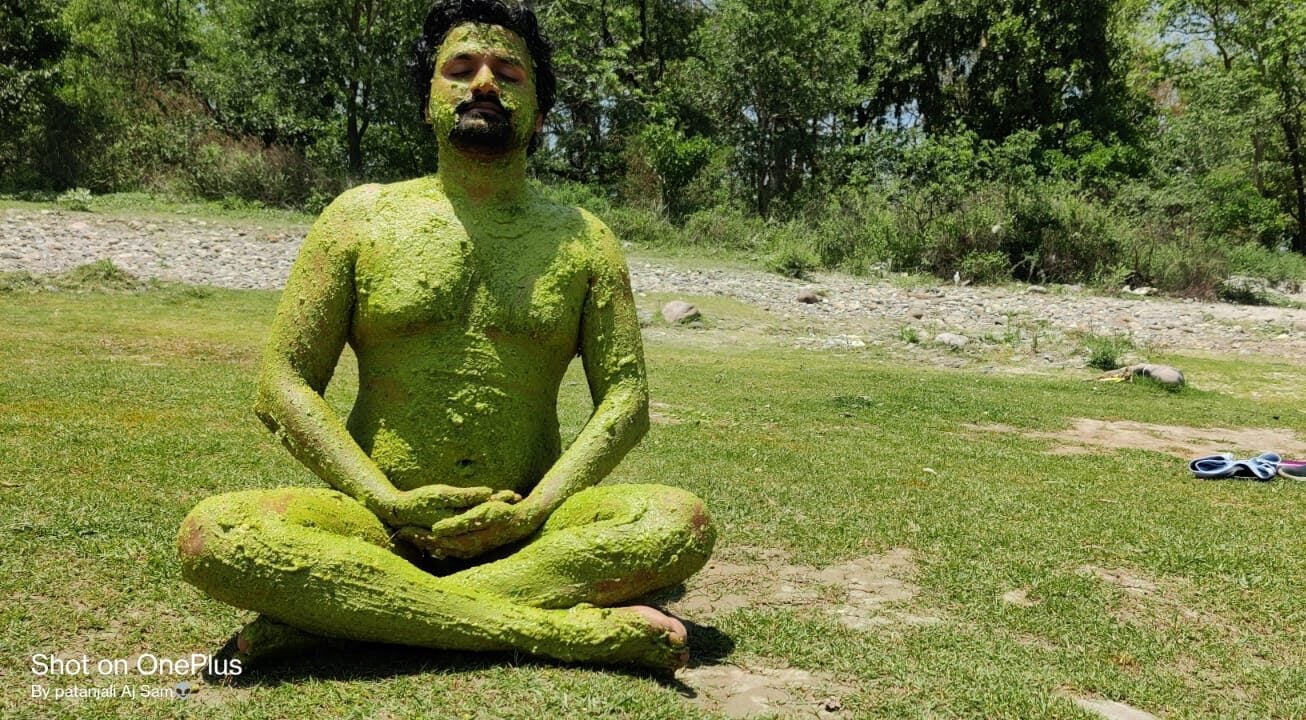

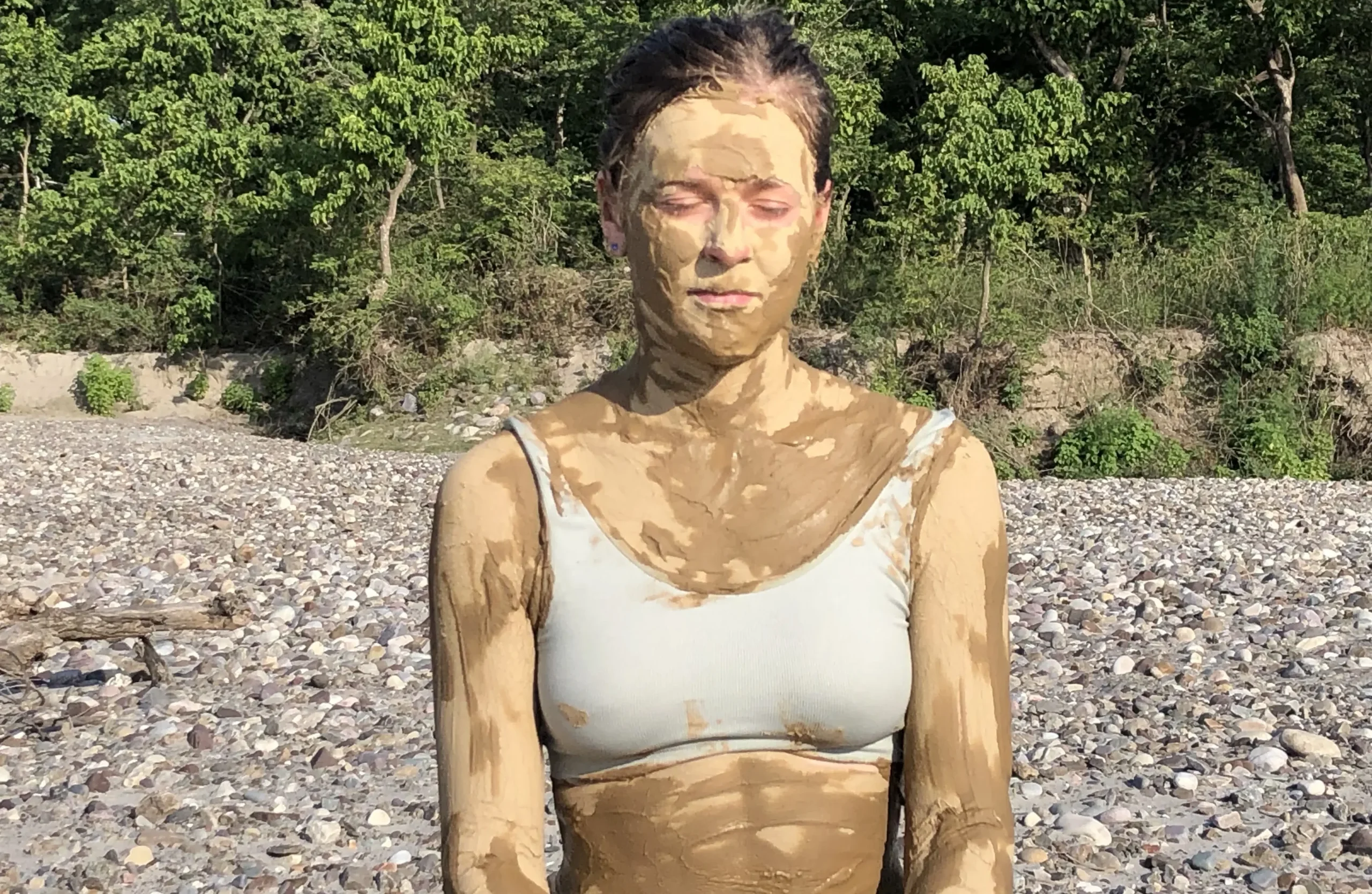
Ayurvedic Mud Therapies
Mud is an important element of nature with many important minerals that have positive impact on our health. Mud is capable of absorbing number of toxins from body that benefitting in prevention of many diseases. A mud pack is advantageous in cold compress as it retains the coolness longer. Lastly, it is easily available and a cost-effective treatment option. It also cools & relaxes the body with its moisture.
Mud therapy is given in two ways:
Mud packs – It involves frequent application of mud packs to improve complexion, treat skin acne & spots effectively.
Mud Bath – It involves application of natural salts and mineral rich mud over entire body to treat skin diseases like Psoriasis, Urticaria, Leukoderma, Leprosy and other skin allergic conditions.
Benefit Of Mud Bath :
- It relaxes the muscles.
- Improves blood circulation.
- Improves metabolism having positive impact on digestion.
- It is good for skin & hair.
- Relieves pain & inflammation.
Hot Mud Therapy is very useful for our health, it not only removes toxins but mud has lots of antibacterial, antiviral, antifungal, antipsychotic, antipyretic, antiseptic and other properties.
Benefits of Herbal Mud Bath :
- Reduce inflammation
- Reduce joint stiffness
- Improves blood circulation
- Relax soreness of muscles
- Relieves chronic pain
The sand bath Therapy is not only relaxing but acts like a natural therapy. It cleanses the body much like a sauna. The weight of the hot sand on the body helps the muscles to relax. The body is soothed without any burns.
- Relief is provided from a range of muscular disorders.
- Various skin diseases are healed as well.
- It helps people suffering from arthritis, rheumatism, acne, sciatica and psoriasis among other conditions.
- It cleanses the body and helps to remove toxins through sweating.
- Sand bath has the added benefit of the weight of the hot sand pressing down on the body to help loosen muscles too.
- It also helps relieve musculoskeletal and arthritic pain.
- Stimulate lymphatic flow and detoxify the body.
Green herbal Detox” body pack. This pack is a unique combo of many herbs like spirulina, Curcuma, manjishtha, sandalwood, turmeric, mustard, Epsom salt, and many more, which helps to reduce muscle fatigue, remove toxins and give fresh, smooth and glowing skin.
This treatment has a great palliative effect in all skin disorders. Turmeric is rich in a nutrient called curcumin. It is also rich in antioxidants and antimicrobial effects. Curcumin is able to suppress the excessive production of TNF-alpha by activated macrophages. Rice powder is also a great anti-inflammatory agent, and a good antioxidant. Thus, ganji turmeric pack helps in curing all skin disorders.
- To encourage the function of skin.
- To regulate and increase the movement of blood through vessels.
- It helps to improve the coetaneous circulation.
- It improves Skin disorders like Urticaria, Eczema.

Wet Sheet Pack + Hot & Cold compress massage
The Wet Sheet Pack involves wrapping the body in a damp sheet to induce relaxation and promote circulation. Combined with a Hot & Cold compress massage, alternating temperatures help soothe muscles, reduce inflammation, and enhance overall well-being through the therapeutic benefits of both warmth and cold therapy.
Wet sheet pack is a modality of hydrotherapy which is used for regulating the body temperature using cold water. In this procedure, the body of the patient is wrapped in wet blankets and then it is covered by dry blankets. The procedure is completed in three steps. First step is wet stage. In this stage, the temperature of the body is brought down. The second stage is neutral. In this stage, the body is kept under neutral temperature. This induces better sleep. The third stage is the heating stage where the temperature of the body is raised which helps in decongestion of the organs of the body by dilating the blood. There are different benefits of this procedure. First of all, it helps in bringing down the fever and regulates the body temperature. It helps in decongestion of the organs in the body.
Hot and cold compress massage involves alternately applying heat and cold to specific areas of the body to promote therapeutic benefits. The hot compress helps relax muscles, improve blood circulation, and alleviate tension by increasing tissue flexibility. This warmth also reduces stiffness and promotes a soothing sensation. On the other hand, the cold compress reduces inflammation, numbs pain, and constricts blood vessels, helping to minimize swelling and discomfort. Alternating between hot and cold enhances the body’s natural healing mechanisms, as the heat encourages blood flow and nutrient delivery, while the cold reduces inflammation and provides pain relief. This dynamic combination is commonly used for managing injuries, relieving muscle soreness, and promoting overall relaxation and well-being, making it a versatile and effective technique in massage therapy.
- Hot Compress helps to Treat sports-related musculoskeletal injury.
- Hot Compress helps to Treat sports-related musculoskeletal injury.
- Promote a transient reduction in joint stiffness, muscle pains & spasms.
- Reduce inflammation & congestion in tissues.
- Treat arthritis, muscle spasms, muscle sprains and strains, and even cancer.
- Cold compress helps to Reduce your metabolic rate, inflammation, circulation, muscle spasms and pain.
- Cool skin surface & underlying tissues.
- Override your pain sensation.

Arm & Foot Bath
An Arm & Foot Bath involves immersing the arms and feet in warm water infused with salts, essential oils, or therapeutic ingredients. This soothing treatment promotes relaxation, improves circulation, and alleviates muscle tension. It is commonly used for stress relief, detoxification, and enhancing overall well-being in spa and wellness practices.
An Arm & Foot Bath is a therapeutic practice that involves immersing the arms and feet in warm water infused with various ingredients to promote relaxation, improve circulation, and alleviate stress and discomfort. This holistic wellness technique has been employed for centuries across various cultures, with its roots in ancient bathing rituals and traditional medicine.
The process typically begins by filling a basin with comfortably warm water. Many practitioners enhance the experience by adding Epsom salts, essential oils, herbs, or other soothing substances to the water. Epsom salts, rich in magnesium, are known for their muscle-relaxing properties, while essential oils contribute aromatic benefits that can have calming or invigorating effects.
As individuals submerge their arms and feet into the bath, the warmth helps dilate blood vessels, facilitating better blood flow and oxygenation to the extremities. This can be particularly beneficial for those experiencing tension, fatigue, or mild pain in these areas. Additionally, the experience can aid in reducing inflammation, promoting joint flexibility, and softening the skin.
Apart from the physical benefits, an Arm & Foot Bath also serves as a form of self-care and relaxation. The sensory combination of warm water, pleasant scents, and the act of slowing down can contribute to stress relief and mental well-being. It offers a simple yet effective means of unwinding, making it a popular practice in spas, wellness centers, and home-based self-care routines alike.
- Relieves cold & cough
- Asthma
- Sinusitis
- Headache
- Knee pain
- Sciatica
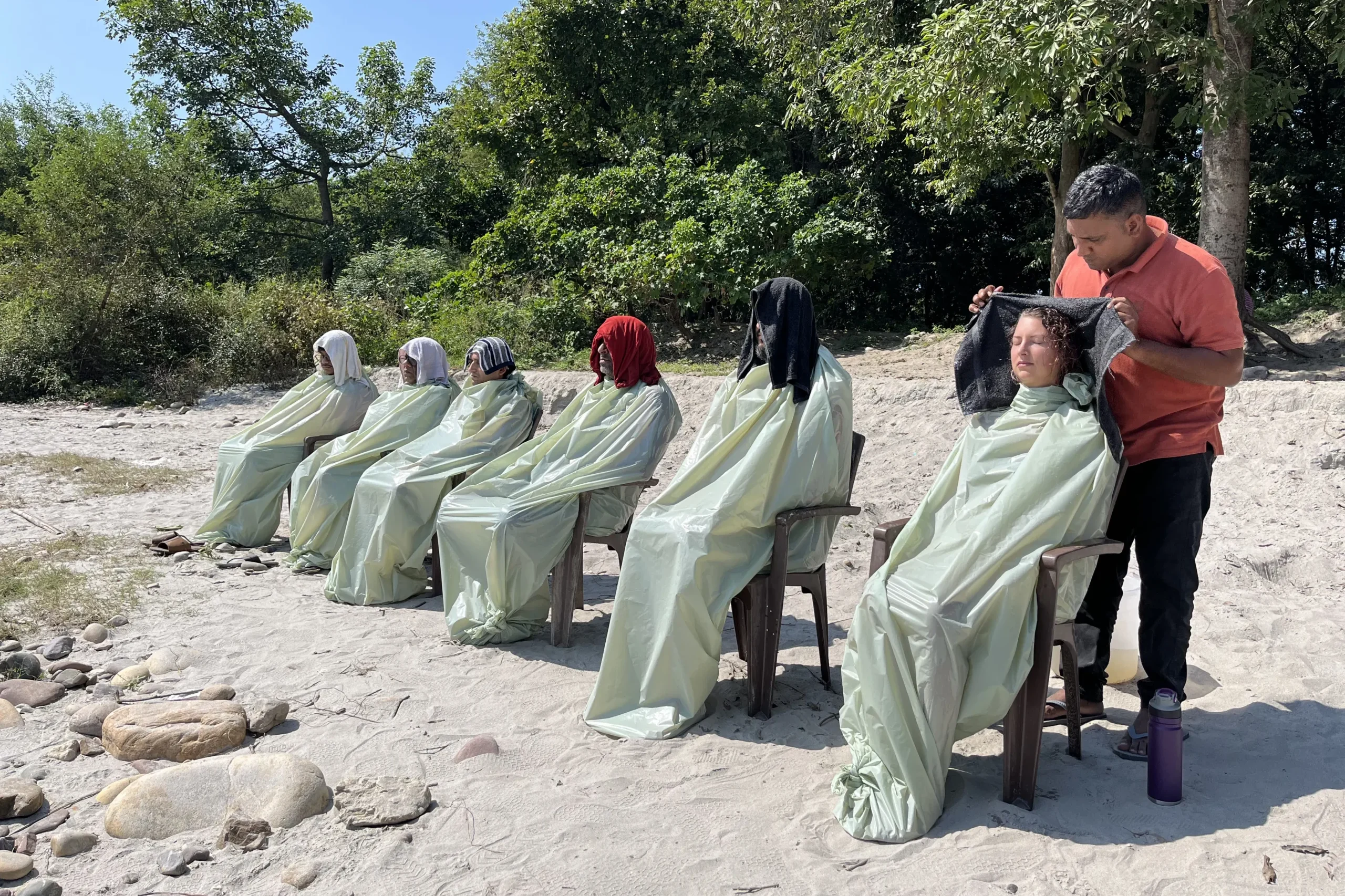
Greenhouse Thermoleum Therapy
Greenhouse Thermoleum Therapy utilizes heat in a greenhouse setting for holistic healing, aligning with Ayurvedic principles of wellness.
GHT – greenhouse thermoleum is a natural way of healing different health problems. Sunlight helps to regulate melatonin production in the body, which is necessary to maintain the circadian rhythms of the body. Melatonin is an essential hormone released by the pineal gland of our brain. This hormone regulates our sleep-wake cycle. The production of Melatonin is affected by the intensity of sunlight. It increases during the night and falls during the daytime.
Greenhouse thermoleum therapy helps to keep the hormonal level in check and keeps disorders at bay.
- It has been found that decrease in exposure to sunlight may develop physical and psychological.
- Maintain the circadian rhythms of the body
- Greenhouse thermoleum helps to improve the blood circulation in the body
- It is also necessary for the absorption of calcium by the bones.
- Research also suggests that UVB rays promote the synthesis of vitamin D3 in the human body
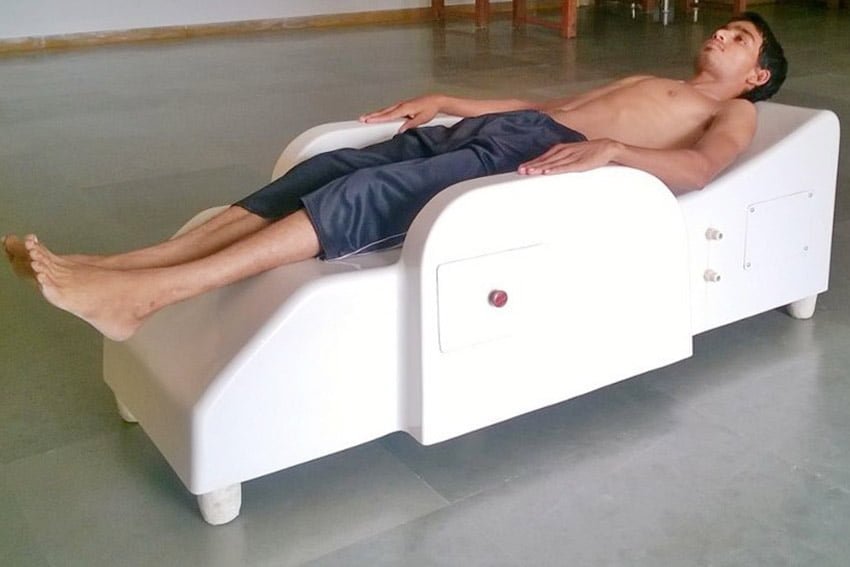
Spinal Bath
A “Spinal Bath” typically refers to a therapeutic technique involving immersing the spinal region in warm water. This method aims to promote relaxation, alleviate muscle tension, and enhance circulation. It is often used in alternative medicine practices as a means of relieving stress and supporting overall well-being.
This bath provides a soothing effect to the spinal column and thereby influences the central nervous system. It is performed in a specially designed tub with its back raised for providing proper support to the patient’s head. Spinal bath can be given in cold, neutral & hot temperatures.
Cold Spinal Bath relieves irritation, fatigue, hypertension and excitement. It is performed to treat various nervous & mental disorders, stress, hysteria, fits & loss of memory.
Neutral Spinal Bath is soothing & sedative, especially for the highly irritable patients & best treatment for insomnia & relieving vertebral tension.
Hot Spinal Bath helps stimulate nervous system, especially during a depressed state. It relieves vertebral pain (spondylitis) & muscular back pain. It relieves sciatica pain & gastrointestinal disturbances.
- Nervous system is strengthened and digestion improves.
- It is very helpful in menstrual disorder, PCOD, PCOS.
- Prostate gland enlargement, Kidney stone, High creatinine level, Fistula, Piles, Parkinson disease.

Hip Bath
A hip bath is a therapeutic practice involving immersing the hips and lower abdomen in warm water. It promotes relaxation, relieves muscle tension, and may alleviate discomfort. This traditional remedy is believed to improve circulation, reduce inflammation, and enhance overall well-being through the targeted immersion of the hip region.
Hip Bath is one of the most useful forms of Hydrotherapy treatment in which a special type of tub is used. The entire region from naval region to the upper half of thighs is immersed in water. This treatment is an important part of the rejuvenation package and is also used to treat problems of digestion, bowel, kidney, bladder, and menstrual disorders, including PCOS & PCOD.
- Relieves pain, swelling or irritation in the perineum.
- Relieves soreness, burning & inflammation.
- Useful for anal problems like hemorrhoids, infection, constipation.
- Provides relief and boosts healing in women after vaginal childbirth.
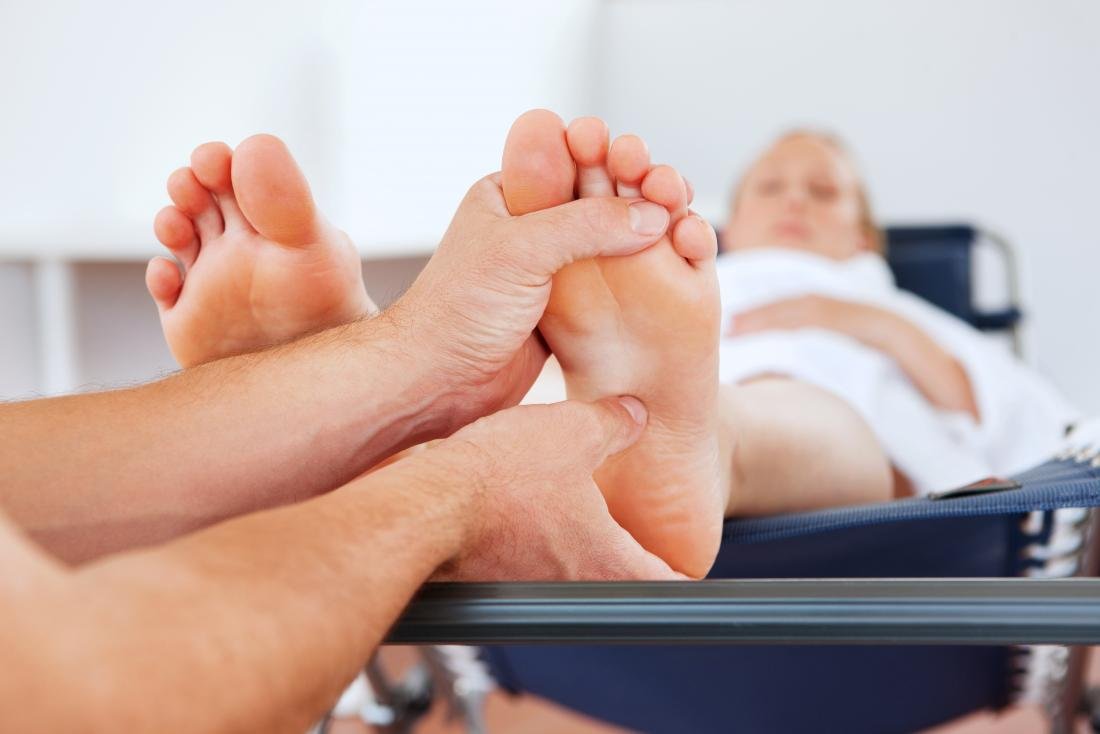
Foot Reflexology massage
Foot reflexology is a therapeutic massage technique that involves applying pressure to specific points on the feet to stimulate corresponding areas throughout the body. Believed to promote relaxation and balance energy, it aims to alleviate tension, improve circulation, and enhance overall well-being through targeted reflex points on the feet.
Foot reflexology massage is a holistic therapeutic technique rooted in the ancient belief that specific areas on the feet correspond to various organs and systems throughout the body. This practice is based on the principle that applying pressure to these reflex points can promote relaxation, balance energy flow, and stimulate healing responses in corresponding body parts.
During a foot reflexology massage, a trained therapist uses their hands, fingers, and thumbs to apply pressure to specific points on the feet. The session typically begins with a warm foot soak to relax the muscles and prepare the feet for treatment. The therapist then uses various massage techniques, such as kneading, rubbing, and gentle stretching, to target the reflex points.
Proponents of foot reflexology believe that stimulating these reflex points can help release tension, improve circulation, and enhance the body’s natural ability to heal itself. It is often used as a complementary therapy for promoting overall well-being and alleviating various health issues, including stress, anxiety, and certain physical ailments.
Beyond its potential physical benefits, foot reflexology is also valued for its ability to induce deep relaxation and reduce stress. Many people find the treatment to be a soothing and enjoyable experience, making it a popular choice for those seeking relaxation and holistic wellness.
It’s important to note that while many individuals report positive effects from foot reflexology, scientific evidence supporting its efficacy is limited, and its benefits may vary from person to person. As with any alternative therapy, individuals should consult with healthcare professionals before incorporating foot reflexology into their wellness routine, especially if they have underlying health conditions.
- Stress and Relaxation.
- Pain Management.
- Digestion.
- Eyestrain.
- Improved Sleep.
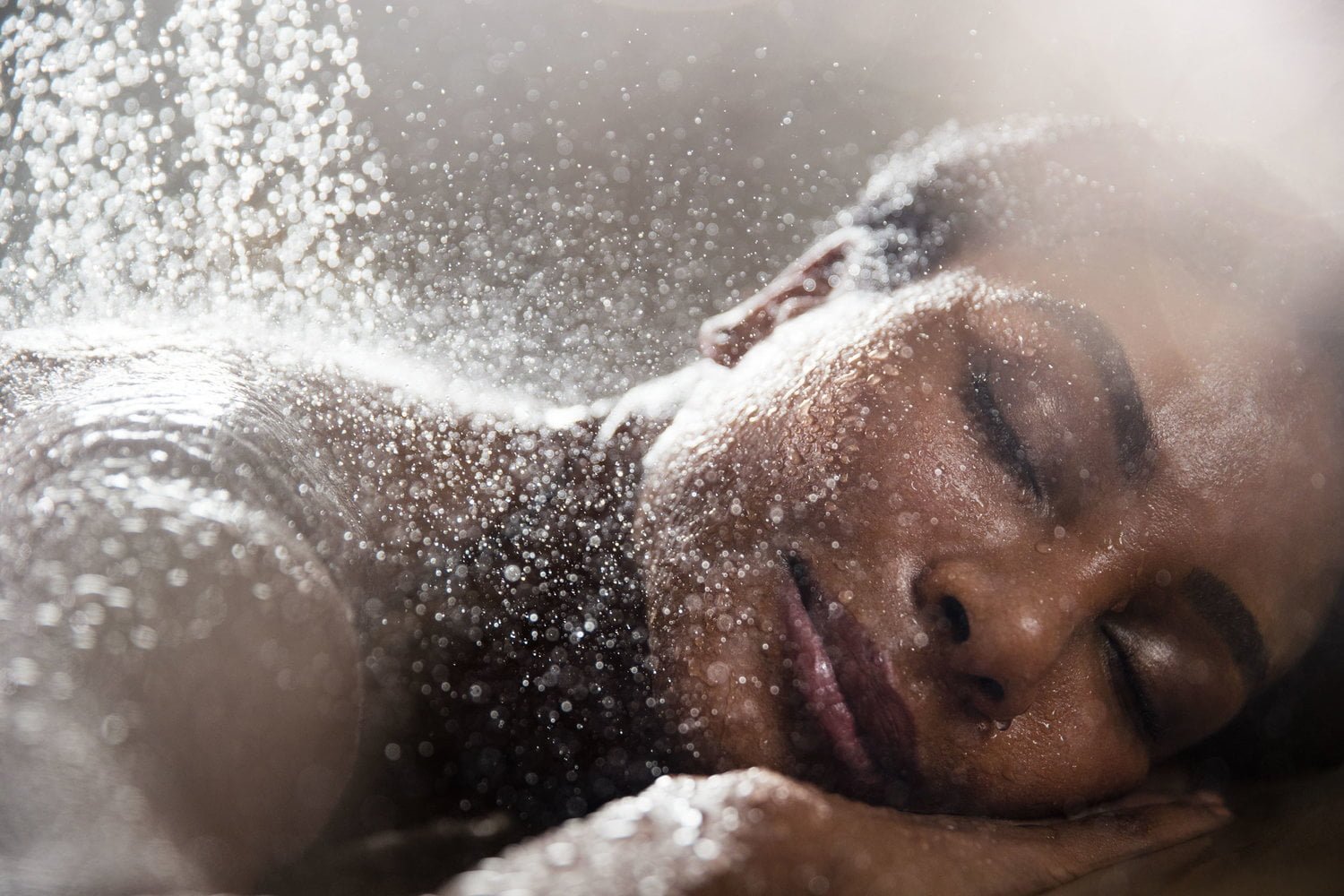
Hydrotherapy
Hydrotherapy is a therapeutic approach utilizing water for health benefits. It involves various treatments such as hot baths, cold compresses, or underwater exercises to promote physical and mental well-being. The water’s buoyancy and temperature can alleviate pain, improve circulation, and enhance relaxation, aiding in the healing process.
We are all aware of the fact that, ‘water is life’ and is one of the essential elements for healthy body. All the important activities of the body are regulated and dependent on water. It carries all the hormones, vitamins, chemicals and oxygen to all the parts of the body. It is therefore called the universal solvent and even serves as a natural remedy for many diseases. As a result, hydrotherapy is used widely for the treatment of varied diseases.
Hydrotherapy is the use of water to revitalize, maintain, and restore health. Hydrotherapy treatments include saunas, steam baths, foot baths, sitz baths, and the application of cold and hot water compresses.
Hydrotherapy is a therapeutic approach that involves the use of water to promote health and well-being. This practice has been employed for centuries, dating back to ancient civilizations such as the Greeks and Romans who recognized the healing properties of water. Hydrotherapy encompasses a variety of techniques and treatments that leverage the physical properties of water, including temperature and pressure, to achieve therapeutic effects.
One common form of hydrotherapy is immersion in hot or cold water, known as balneotherapy. Hot water immersion, such as in hot tubs or saunas, can help relax muscles, improve circulation, and alleviate stress. Cold water immersion, on the other hand, may reduce inflammation and promote recovery after intense physical activity.
Water exercises, often performed in heated pools, are another aspect of hydrotherapy. These exercises provide a low-impact environment, making them suitable for individuals with joint problems or limited mobility. The buoyancy of water reduces the impact on joints while simultaneously providing resistance for strengthening muscles.
Hydrotherapy is also employed in rehabilitative settings, aiding in the recovery of injuries or surgeries. The controlled environment of water allows for gentle yet effective movement, facilitating improved range of motion and muscle function.
- Helps maintain hydration of the body
- Helps in proper secretion of body fluids and maintenance of Ph.
- Aids digestion and prevents constipation
- Improves skin condition and nourishes it
- Maintains the flexibility of joints
- Helps in detoxification
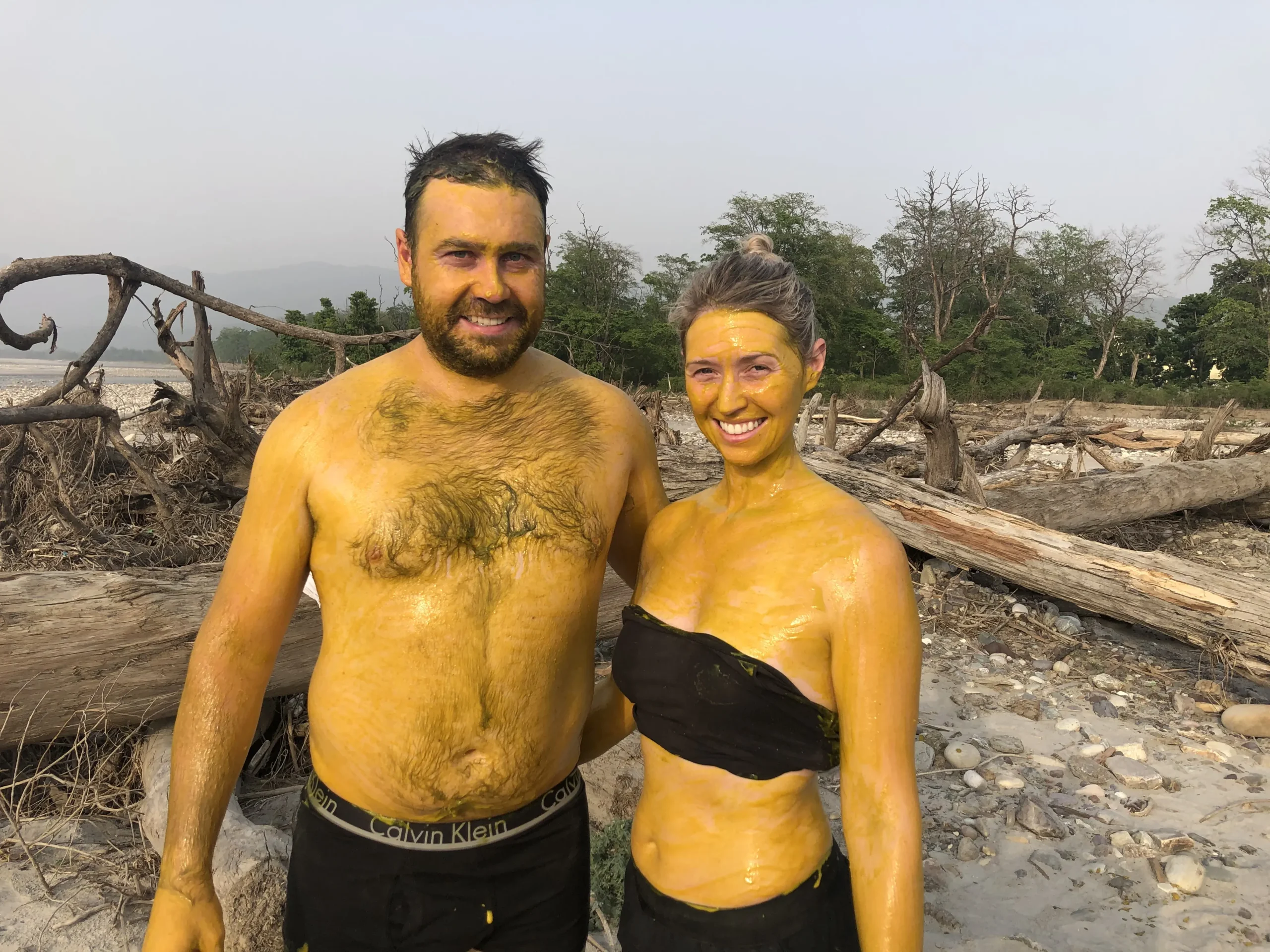
Ganji Turmeric Pack
The Ganji Turmeric Pack is a skincare product infused with turmeric, known for its anti-inflammatory and antioxidant properties. This pack aims to brighten and rejuvenate the skin, providing a natural glow. Its formulation combines traditional wisdom with modern skincare, offering a holistic approach to skin wellness.
Ganji turmeric pack has a great palliative effect in all skin disorders. Turmeric is rich in a nutrient called curcumin. It is also rich in antioxidants and antimicrobial effects. Curcumin is able to suppress the excessive production of TNF-alpha by activated macrophages. Rice powder is also a great anti-inflammatory agent, and a good antioxidant. Thus, ganji turmeric pack helps in curing all skin disorders.
The term “Ganji” is often associated with a traditional South Asian dish known as rice congee or rice porridge. It is a simple and easily digestible food made by boiling rice in water until it reaches a porridge-like consistency. Turmeric, on the other hand, is a spice widely used in South Asian cuisine known for its vibrant color and potential health benefits.
A “Ganji Turmeric Pack” could potentially refer to a product or mixture designed to enhance the traditional rice congee with the addition of turmeric. This could offer both flavor and the potential health benefits associated with turmeric, such as anti-inflammatory and antioxidant properties.
- To encourage the function ofskin
- To regulate and increase the movement of blood throughvessels
- It helps to improve the coetaneouscirculation
- It improves Skin disorders like Urticaria, Eczema
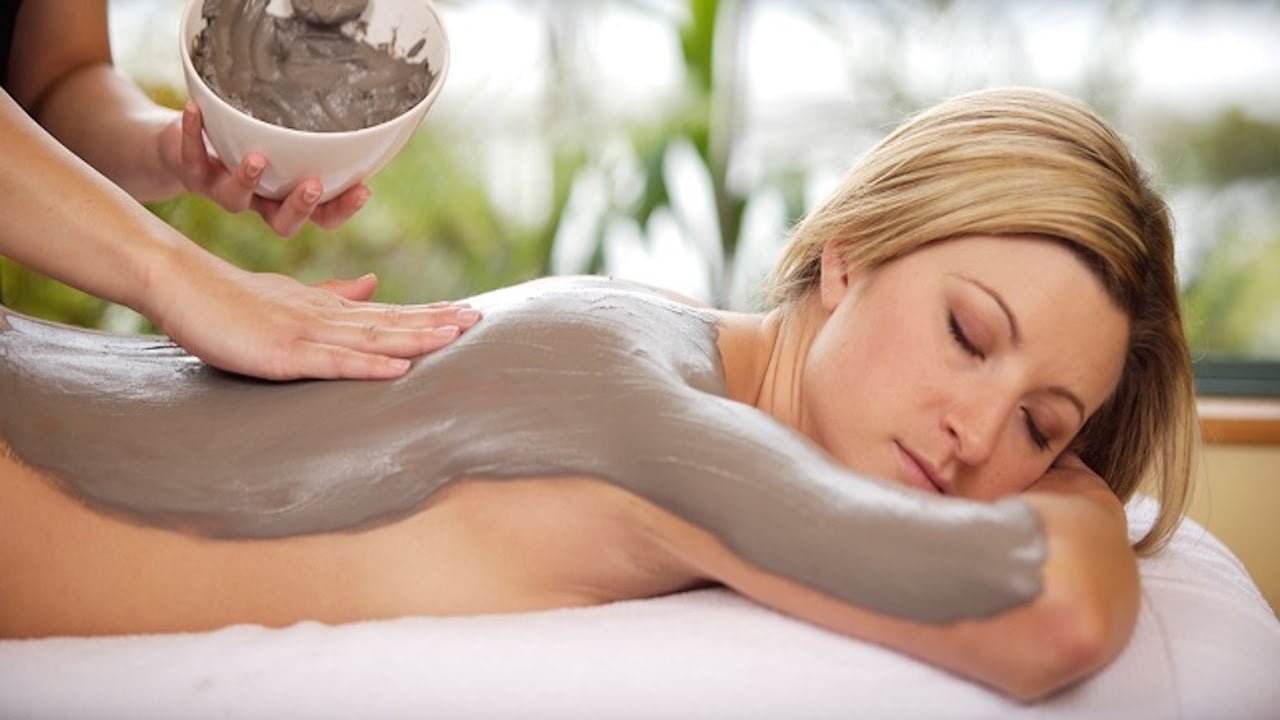
Wet Abdomen & Back Pack
Wet Abdomen & Back Pack treatment involves applying a damp cloth to the abdomen and back, often with warm water or herbal solutions. This method aims to alleviate pain, reduce inflammation, and promote relaxation. It is commonly used in holistic and natural health practices for various therapeutic benefits.
Targeted Pain Relief: Designed to ease discomfort in the lower back and abdomen areas, this multipurpose hot and cold pack is your companion for soothing relief. The elastic Velcro strap ensures it stays securely in place, allowing you to move freely while applying the pack.
Reusable Versatility: This pack is a versatile companion. It can be used as a heat pack and a cold pack, depending on your needs. Say goodbye to single-use options and embrace the sustainability of our product.
Common Ailments: It’s your go-to solution for lower back pain, stomach aches, and menstrual cramps. Whether you’re dealing with aching back muscles or abdomen discomfort, this pack is designed to provide the relief you seek.
Comprehensive Healing: Relieve pain, treat injuries, ease muscle tension, improve blood circulation, and enhance your well-being with a touch of aromatherapy. We’ve infused our packs to support your psychological and physical health.
- Abdominal compress is useful in cases of gastritis, hyperacidity, indigestion, poor blood circulation and other complaints relating to the abdominal organs.
- Increases blood circulation and hence, toxins accumulated in the depths of our organs start leaving their place. It’s a powerful way to detox the body. Wet pack is even more effective when followed with an enema, as the circulated toxins are eliminated through enema.
- When applied on abdomen, it relieves all forms of indigestion. It is powerful in curing ulcers, IBS, GERD, acidity, bloating, constipation, stomach pain and colitis.
- When applied on the neck, it helps get rid of thyroid problems.
- When applied on the forehead, it increases blood circulation near the brain and helps get rid of headaches, migraines and other mental disorders.
- It tones up the stomach and helps get rid of exces fat.
- Increases blood circulation, which helps the toxins to leave their place and finally exit through stool/urine.
- Cures indigestion, ulcers, acidity, bloating, diarrhea, constipation, stomach pain, and colitis.
- Relieves tonsils, thyroid, and all throat infections.
- Helps to get rid of headaches, migraine, anxiety, and other mental disorders.
- Removes excess fat around the abdominal region.
- Helps to cure any primary disease like cough, cold, fever, etc.

Face Pack
A “Face Pack treatment” involves applying a specialized mixture of skincare ingredients, such as clays, herbs, and vitamins, onto the face. This treatment aims to cleanse, exfoliate, and nourish the skin, promoting a healthier complexion by addressing specific skincare concerns and enhancing overall skin texture and appearance.
In this therapy the medicinal properties of different herbal mud is used to treat partial body by applying the thick layer of herbal mud directly or indirectly on the skin.
This helps to improve the skin circulation and energizing the skin tissues. It dilutes and absorbs the toxic substances of face and ultimately eliminate them.
Face Pack Ayurvedic therapy is a skincare practice rooted in Ayurveda, the traditional medicine system of India. This therapy involves the application of a herbal concoction or paste onto the face to promote skin health and address various skin concerns. The face pack typically consists of Ayurvedic ingredients such as turmeric, neem, sandalwood, aloe vera, and other natural substances known for their therapeutic properties.
Ayurvedic face packs are formulated to balance the three doshas (Vata, Pitta, and Kapha) in the skin, promoting harmony and addressing specific skin issues. These packs are believed to cleanse, nourish, and rejuvenate the skin, providing a holistic approach to skincare. Regular use of Face Pack Ayurvedic therapy is thought to enhance skin texture, tone, and radiance while promoting overall well-being by aligning with Ayurvedic principles of holistic health and balance.
- It helps in relaxing the skin
- It hydrates the skin
- Helps in unclogging your pores
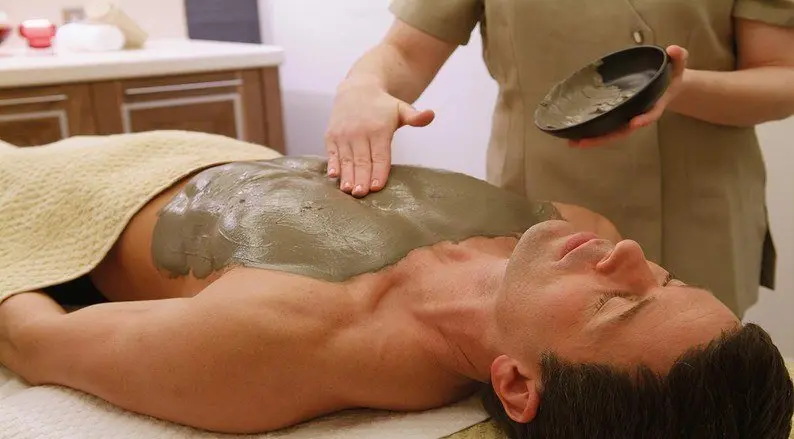
Abdomen Mud Pack
Abdomen Mud Pack treatment involves applying a therapeutic mud mixture to the abdominal area. The mud’s minerals are believed to detoxify, soothe, and promote circulation, offering potential benefits such as skin improvement and relaxation. However, scientific evidence supporting its efficacy is limited, and it is commonly used in traditional and alternative therapies.
Abdomen Mud Pack therapy is a holistic health practice that involves applying a specially prepared mud pack to the abdominal region to promote wellness. The mud used in this therapy is typically a mixture of mineral-rich clay, water, and herbal extracts. The pack is applied to the abdomen and left in place for a specified duration. Proponents of this therapy claim that the mud’s natural properties can help detoxify the body, improve circulation, and alleviate digestive issues. The mud pack is believed to draw out toxins, reduce inflammation, and stimulate the organs in the abdominal area, such as the liver and intestines. Advocates suggest that Abdomen Mud Pack therapy may contribute to overall well-being by supporting the body’s natural healing processes. It is important to note that while some individuals find benefit from such therapies, scientific evidence supporting the specific claims of Abdomen Mud Pack therapy may be limited. Always consult with healthcare professionals before trying alternative treatments.
- Exfoliation: The mud helps remove dead skin cells, promoting a smoother complexion.
- Detoxification: Mud may assist in drawing out impurities and toxins from the skin.
- Improved Circulation: Application of mud can stimulate blood flow, enhancing circulation in the treated areas.
- Skin Tightening: Mud packs may temporarily tighten and tone the skin, reducing the appearance of pores and fine lines.
- Hydration: Some mud packs contain minerals that can help hydrate the skin.
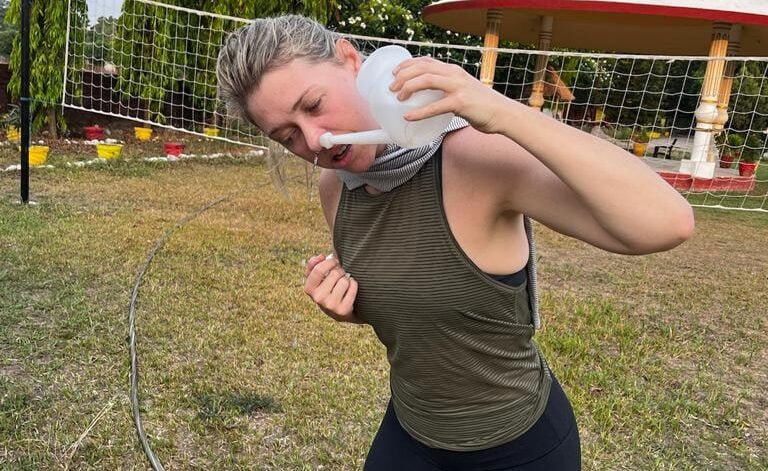
Jal Neti
Jal Neti is a traditional yogic nasal cleansing technique where lukewarm saline water is poured through one nostril and drains out through the other. This practice helps clear nasal passages, alleviate sinus congestion, and promote overall respiratory health by flushing out impurities and promoting nasal hygiene.
We are all aware of the fact that, ‘water is life’ and is one of the essential elements for healthy body. All the important activities of the body are regulated and dependent on water. It carries all the hormones, vitamins, chemicals and oxygen to all the parts of the body. It is therefore called the universal solvent and even serves as a natural remedy for many diseases. As a result, hydrotherapy is used widely for the treatment of varied diseases.
Hydrotherapy is the use of water to revitalize, maintain, and restore health. Hydrotherapy treatments include saunas, steam baths, foot baths, sitz baths, and the application of cold and hot water compresses.
Some of the key advantages of Jal Neti include:
- Clears Nasal Passages : Jal Neti helps remove excess mucus, dust, and allergens from the nasal passages, providing relief from congestion and improving airflow.
- Sinus Relief : It can alleviate sinusitis and sinus-related discomfort by flushing out irritants and promoting sinus drainage.
- Reduced Allergy Symptoms : Regular practice may reduce allergy symptoms by removing allergens from the nasal passages, providing relief from sneezing, itching, and congestion.
- Improved Breathing : Clean nasal passages can enhance breathing capacity, making it easier to take deep, full breaths.
- Enhanced Sense of Smell and Taste : By clearing the nasal passages, Jal Neti can improve your ability to smell and taste, which is closely tied to overall enjoyment of food and life.
- Headache Relief : It may help alleviate headaches, particularly those related to sinus congestion or tension.
- Better Focus and Mental Clarity: Many practitioners report increased mental clarity and improved concentration after performing Jal Neti.
- Stress Reduction: The rhythmic and meditative aspects of the practice can have a calming effect, reducing stress and promoting relaxation.
- Prevention of Respiratory Infections: By keeping the nasal passages clean and moist, Jal Neti may reduce the risk of respiratory infections.
- Support for Meditation: A clear and unobstructed nasal passage is important for breathing exercises and meditation, making Jal Neti a useful preparation for these practices
Traditional Panchkarma Therapies
Panchakarma is a comprehensive set of therapeutic procedures rooted in Ayurveda, an ancient system of medicine from India. These traditional therapies aim to purify the body, balance doshas (bio-energies), and promote overall well-being. The word “Panchakarma” itself means “five actions,” reflecting the five main procedures involved in this detoxification and rejuvenation process.
Panchakarma therapies are tailored based on an individual’s constitution, imbalances, and health goals. These traditional treatments not only address specific ailments but also enhance overall vitality and resilience, promoting a holistic approach to health and wellness. It is essential to undergo Panchakarma under the guidance of experienced Ayurvedic practitioners to ensure personalized and effective results

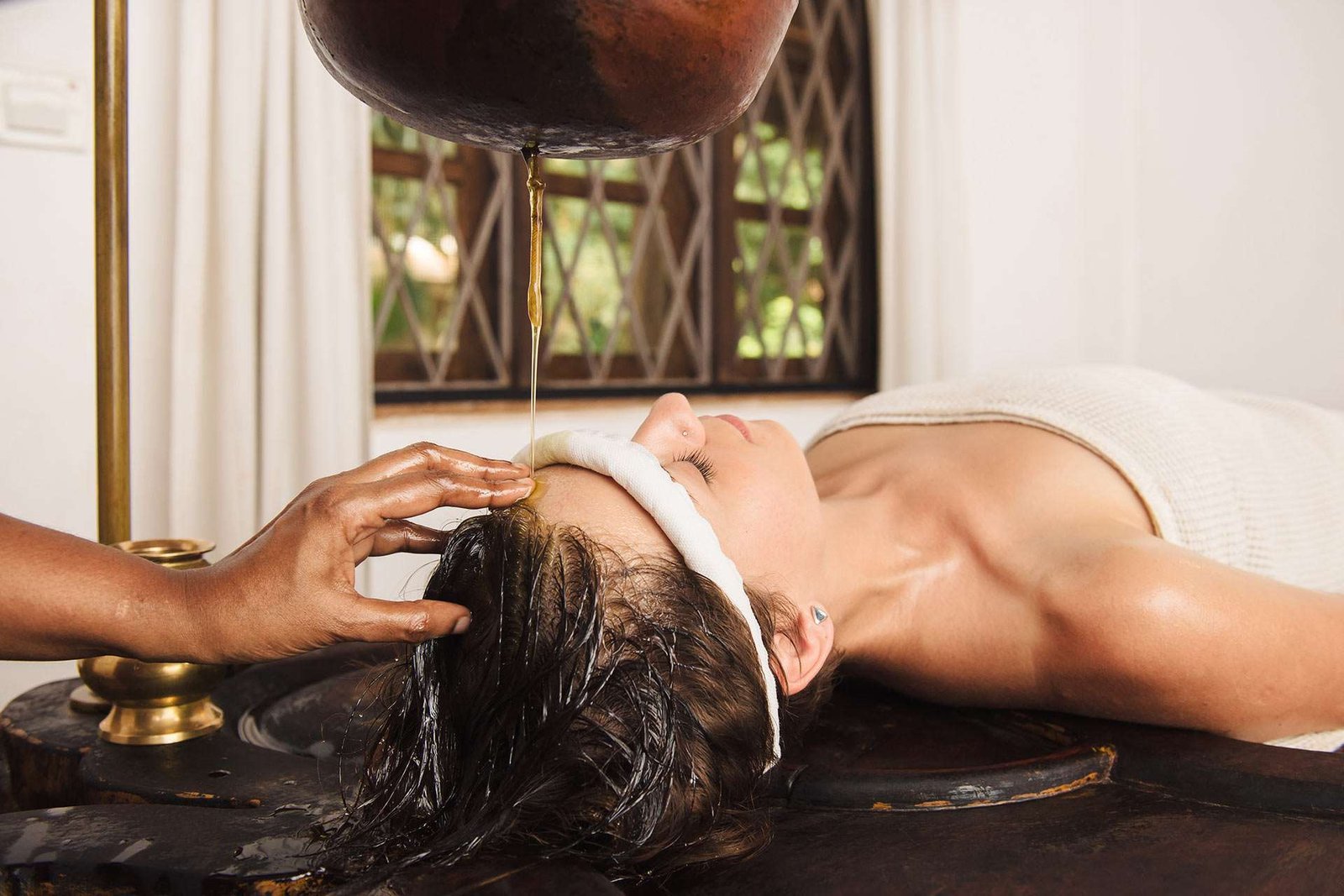
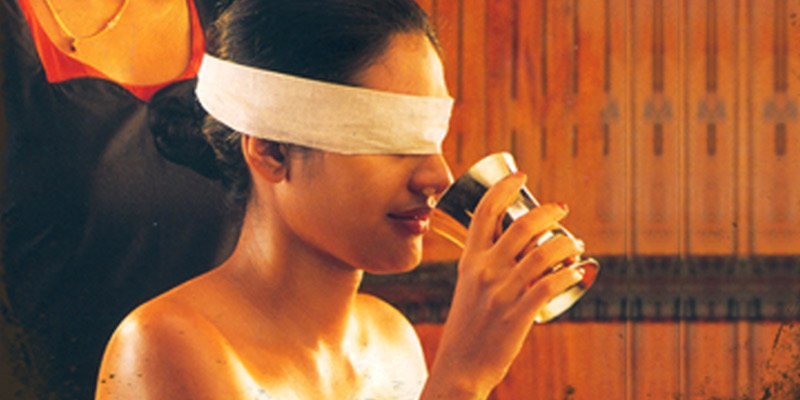
Vaman
Vamana therapy, a component of Panchakarma in Ayurveda, involves controlled vomiting to eliminate excess Kapha dosha, promoting detoxification and balance in the body. This traditional therapeutic procedure aims to treat respiratory conditions, allergies, and other disorders associated with Kapha imbalance by expelling toxins through induced emesis.
Vamana is a vomiting process. It is a purification process by which vitiated kapha is expelled from the body by vomiting. Your body is treated with internal or external oilation & fomentation therapies to liquify toxins (kapha) & let them gather at upper layers. Then through emetic medicine you are induced to vomit clearing the toxins from tissues. It is beneficial for bronchial asthma, cough and cold, chronic indigestion, lymphatic congestion and edema.
Vaman therapy, is a therapeutic procedure in Ayurveda, the traditional system of medicine in India. It is one of the five purification therapies (Panchakarma) aimed at eliminating excess Kapha dosha from the body. Kapha imbalance is associated with conditions such as respiratory disorders, allergies, and certain skin diseases.
During Vamana treatment, the individual undergoes controlled emesis induced by the administration of therapeutic substances, typically herbs, that stimulate the expulsion of accumulated toxins and excess Kapha from the stomach. This process helps to cleanse and balance the body, promoting overall well-being. Vamana is often recommended for individuals with Kapha-dominant disorders, contributing to the restoration of doshic equilibrium and improving health. However, the procedure requires careful assessment and supervision by qualified Ayurvedic practitioners to ensure its appropriateness and safety for each individual.
- Useful treatment for anemia, chronic indigestion, sinus problems, cough and cold.
- Effective treatment for chronic diabetes, edema, epilepsy, skin diseases, fever, loss of appetite.
- Treats nausea & food poisoning.
- Helpful in treated repeated tonsillitis.
- It can treat asthma & pneumonia.

Virechana
Virechana Therapy is a traditional Ayurvedic detoxification method involving the controlled administration of purgative substances to eliminate excess Pitta dosha and toxins from the body. This therapeutic cleansing aims to balance digestive functions, promote liver health, and enhance overall well-being through natural purgation.
Virechana is a traditional Ayurvedic therapeutic procedure aimed at detoxifying the body by eliminating excess Pitta dosha, or fire element, from the gastrointestinal tract. Rooted in ancient Indian healing practices, Ayurveda considers an imbalance in the three doshas—Vata, Pitta, and Kapha—as the source of various health issues. Virechana specifically addresses issues related to excessive Pitta, which is associated with heat, inflammation, and toxicity in the body.
The treatment involves administering purgative substances, often herbal formulations, to induce controlled and systematic bowel movements. These substances stimulate the liver and gallbladder, promoting the release of bile and other digestive enzymes. This process facilitates the elimination of accumulated toxins and metabolic waste from the intestines. The goal is to restore the balance of doshas, enhance digestive functions, and promote overall well-being.
Virechana is commonly employed for conditions such as skin disorders, liver disorders, chronic fever, and other Pitta-related imbalances. The procedure is usually conducted under the guidance of a qualified Ayurvedic practitioner, who tailors the treatment to an individual’s constitution and health condition. Prior to undergoing Virechana, individuals typically undergo a preparatory phase called “Purvakarma” to ready the body for the detoxification process.
While Ayurvedic treatments like Virechana have been practiced for centuries, it is crucial to seek guidance from a trained Ayurvedic practitioner and consider individual health needs before undergoing any detoxification procedure.
- Detoxification of accumulated Pitta dosha.
- Helps in reducing fever & constipation.
- Prevents toxin accumulation in the GI tract.
- Normalizes blood pressure & menstrual problems.
- Effective treatment for piles, acidity, ulcers, liver/ spleen diseases, jaundice, inflammations.
- Cleanses body from poisoning.
- Cures mild and chronic skin disorders.
- Relieves headaches, anemia, pain in large intestine, non-healing wounds.
- Helps manage diabetes, asthma & heart diseases.
- Reduces gynecological disorders.

Vasti
Vasti Therapy, also known as Basti, is a traditional Ayurvedic therapeutic practice involving the administration of medicated enemas to cleanse and rejuvenate the colon. It aims to balance doshas, improve digestive health, and treat various conditions. The procedure is believed to promote overall well-being and restore harmony in the body.
The process involves administering medicated substances such as herbal decoction, oils, milk or ghee into your rectum to cleanse it. Vasti works effectively for complex and chronic vata dominated disorders & works well on arthritis, piles & constipation. It can also treat Parkinsonism, convolutions & sterility.
Vasti, also known as Basti, is a therapeutic procedure in traditional Ayurvedic medicine that involves the administration of medicinal substances through the rectum. The term “Vasti treatment” specifically refers to this therapeutic enema, which plays a crucial role in Ayurvedic detoxification and rejuvenation practices.
In Vasti treatment, a carefully prepared herbal decoction or oil-based formulation is introduced into the rectum, allowing the medicinal properties to be absorbed into the bloodstream through the colon. The procedure aims to balance the doshas—Vata, Pitta, and Kapha—which are fundamental principles governing physiological and psychological functions in Ayurveda. By addressing imbalances in the doshas, Vasti is believed to promote overall health and well-being.
Vasti treatment is often employed in various health conditions, including digestive disorders, arthritis, neurological disorders, and certain reproductive issues. The choice of medicated substances in the enema is customized based on the individual’s constitution and the specific health concerns.
Ayurvedic practitioners consider Vasti as a powerful therapy for eliminating toxins (ama) from the body, enhancing digestion, and nourishing tissues. It is also utilized in Panchakarma, a comprehensive Ayurvedic detoxification and rejuvenation program.
While Vasti treatment has a long history in Ayurveda, it is essential to undergo this therapy under the guidance of a qualified Ayurvedic practitioner who can tailor the treatment to individual needs and ensure its safe and effective application.
As anuvasan basti imparts snigdh vasti, niruha imparts shodhana vasti i.e clearance & purification.
- Expels morbid doshas from body
- Prevents accumulation of excreta
- Promotes bulk making thin person stout
- Emaciates obese & overweight people
- Nourishes eyes
- Prevents ageing & premature ageing
- Promotes longevity & anti ageing
- Total body development & nourishment
- Enhances skin color & complexion
- Promotes strength & immunity

Nasyam (Nasal Cleansing)
Nasyam is a traditional Ayurvedic therapy involving the administration of herbal oils or powders through the nasal passages. This practice aims to cleanse and rejuvenate the nasal and sinus passages, promoting respiratory health and balancing the doshas, according to Ayurvedic principles.
Nasyam, a therapeutic procedure in Ayurveda, is a form of nasal cleansing that involves the administration of herbal oils, powders, or medicated liquids into the nostrils. Derived from the Sanskrit word “Nasa,” meaning nose, Nasyam is considered a Panchakarma therapy, a set of detoxification and rejuvenation treatments in traditional Ayurvedic medicine.
The procedure aims to purify and cleanse the nasal passages, which are believed to be connected to the head and neck region, playing a crucial role in maintaining overall health. Nasyam is often recommended for various conditions related to the upper respiratory system, including sinusitis, headaches, allergies, and congestion.
The process involves the application of specific herbal formulations tailored to an individual’s constitution and health condition. A trained Ayurvedic practitioner administers the substances into the nostrils using a prescribed method, and the patient may be instructed to perform specific breathing exercises during and after the procedure.
Nasyam is thought to balance the doshas (Vata, Pitta, and Kapha) within the body, promoting a harmonious state of well-being. The nasal administration allows the therapeutic substances to reach the pranas (vital life forces) located in the head, influencing both physical and mental functions. Overall, Nasyam is regarded as a holistic approach to nasal health, contributing to the restoration of balance in the body and supporting overall wellness in Ayurvedic philosophy.
- Treats headache, migraine, cervical Spondylosis, etc.
- Stress Reduction
- Detoxification
- Improves Skin texture
- Boosts Immunity
- Improves Vision
- Helps with Mental Health
- Clears mucous blockage
- Helps in paralysis
- Opens blocked channels
- Strengthens nasal passages
- Treat nasal infections
- Remedy for congestion
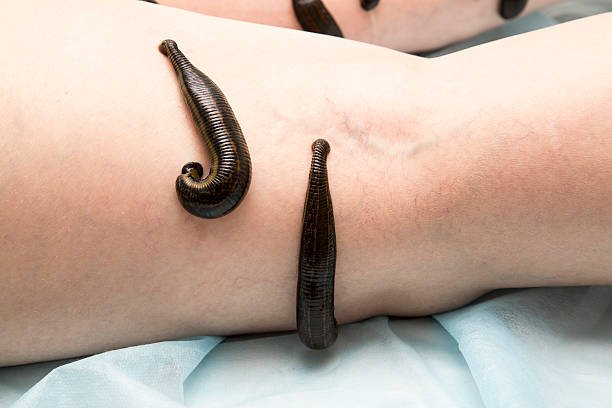
Rakta Mokshana ( Leech Therapy )
Rakta Mokshana, or leech therapy, is an ancient medical practice involving the application of medicinal leeches to the skin. The leeches’ saliva contains bioactive substances that are believed to promote blood circulation and alleviate various health conditions by removing impurities from the bloodstream.
In Ayurveda leech or Jaluka is used to expel out impure blood containing dosha.
In various classical ayurvedic texts like astanghrudyam Sushruta Samhita, there is a wide description of leech therapy. Acharya Sushruta propounds practical guidelines for bloodletting and claims it as the most effective therapy in half of the body ailments.
Among various methods for bloodletting such as Jalaukavacharana karma, Prachhanna karma and Siravedhana karma. Jalaukaavacharna Karma (Leech therapy) is considered as the ideal method to expel out the vitiated blood safely, quickly, and effectively. Application of medicinal leech reportedly increases blood flow within congested tissue via active feeding and indirectly by passive bleeding from leech bite offer detachment.
● Useful in improving blood circulation
● Reduces inflammation in disease like Rheumatoid Arthritis
● Useful in all types of skin disorders like eczema , psoriasis.
● Useful in treatment of varicose veins, alopecia
● Diabetic ulcers
● Vatarakta (Gout)
● Sciatica, lumbar spondylosis,
● Osteoarthritis
● diseases of neck and eyes
● Joint Pain
● Venous congestion
● Joint stiffness
● Different type of infections
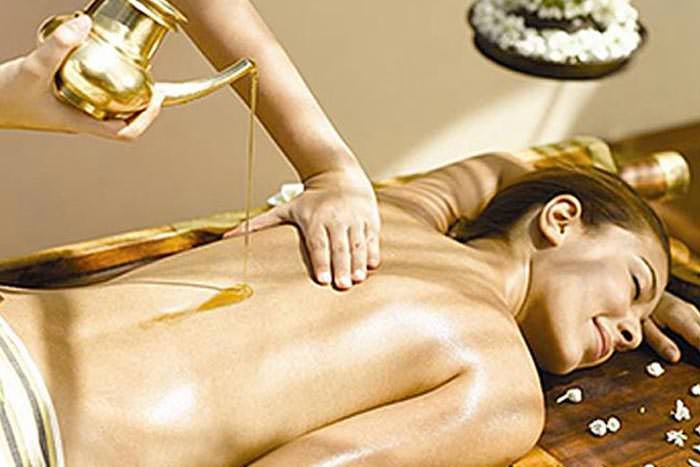
Abhyangam + Steam bath
“Abhyangam + Steam bath” is an Ayurvedic wellness practice involving a therapeutic full-body massage (Abhyangam) with warm herbal oils followed by a steam bath. This combination promotes relaxation, enhances blood circulation, and detoxifies the body, providing a holistic rejuvenating experience for physical and mental well-being.
A four-hand synchronized full-body massage treatment where the body is wrapped with the finest quality medicated oils followed by smooth, gentle movements rubbing the oils deeply into the tissues. This massage is therapeutic as well as highly rejuvenating.
Abhyangam is an ancient Ayurvedic massage therapy originating from India, deeply rooted in the principles of Ayurveda, the traditional system of medicine. The term “Abhyangam” is derived from Sanskrit, where “Abhyanga” means oil massage, and “gam” refers to movement or motion. This therapeutic massage involves the application of warm herbal oils to the entire body, including the scalp and hair, with rhythmic and synchronized strokes.
The primary goal of Abhyangam is to restore balance and harmony to the body, mind, and spirit. Ayurveda believes in the concept of Doshas – Vata, Pitta, and Kapha – representing the fundamental energies that govern physiological and psychological functions. Abhyangam aims to pacify these Doshas, promoting overall well-being and preventing imbalances that may lead to ailments.
During Abhyangam, the warm herbal oils penetrate the skin, nourishing and lubricating the tissues, promoting flexibility and relaxation of muscles and joints. The rhythmic massage strokes enhance blood circulation and lymphatic drainage, aiding in the removal of toxins from the body. Additionally, the therapy is known to calm the nervous system, reduce stress, and induce a sense of tranquility.
Regular Abhyangam is believed to have numerous health benefits, including improved sleep, enhanced skin health, and strengthened immunity. It is often recommended as a preventive measure against various ailments and as a holistic approach to maintaining optimal health. In Ayurveda, Abhyangam is considered not just a physical treatment but also a means to balance the subtle energies within, fostering a state of equilibrium and vitality.
- Rejuvenation: Relaxing, energizing and rejuvenating.
- Beauty: Nourishes and smoothens skin and tissues.
- Therapeutic: improves general wellbeing, stimulates blood circulation, helps in insomnia or as prescribed by the doctor.
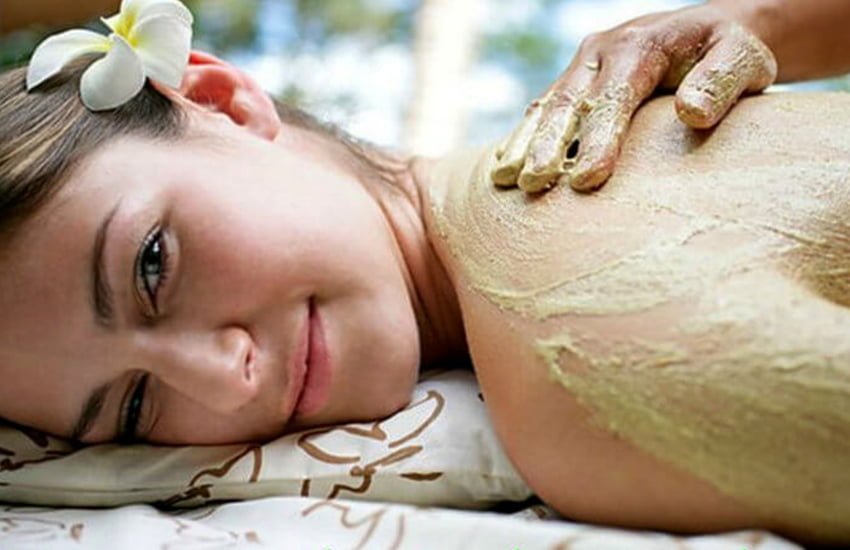
Udvartan massage + Steam bath
Udvartan massage is a traditional Ayurvedic therapy that involves dry herbal powder massage. The therapeutic technique aims to exfoliate and energize the skin, stimulate blood circulation, and promote lymphatic drainage. It is believed to enhance metabolism, reduce cellulite, and provide overall relaxation and rejuvenation.
A Full body massage with warm herbal paste performed by two therapists. The Udvartana treatment is based on the paste containing minerals, Ayurvedic powders and herbs. The treatment removes impurities and improves blood circulation by gently exfoliating the skin and stimulates the lymphatic system to eliminate toxins.
Udvartan massage is a traditional Ayurvedic therapy that originated in India and is known for its holistic approach to wellness. The term “Udvartan” is derived from the Sanskrit words “ud” meaning upward and “vartan” meaning to move. This therapeutic massage involves the application of herbal powders or pastes on the body, followed by a rhythmic and upward massage strokes.
The primary aim of Udvartan massage is to invigorate and revitalize the body, promoting overall well-being. The herbal powders used in the massage are carefully selected based on their therapeutic properties, which may include ingredients like turmeric, neem, sandalwood, and various medicinal herbs. These substances are believed to possess detoxifying, exfoliating, and nourishing qualities, aiding in the removal of toxins, improving circulation, and enhancing skin texture.
The massage technique involves gentle yet firm strokes that stimulate the lymphatic system, promoting the elimination of metabolic waste and boosting the body’s natural detoxification process. Additionally, Udvartan massage is renowned for its potential to improve blood circulation, reduce cellulite, and enhance the overall tone of the skin. It is often recommended in Ayurveda for individuals seeking weight management, as it is believed to balance the Kapha dosha, one of the three fundamental bioenergies in Ayurvedic philosophy associated with water and earth elements.
Overall, Udvartan massage offers a rejuvenating experience that not only addresses physical aspects but also aims to balance the mind and spirit, aligning with the holistic principles of Ayurveda.
- Rejuvenation: relaxing, eases tensed muscles, reduces fatigue and lethargy.
- Beauty: reduces weight, exfoliates skin, slows down aging, makes the skin glow, nourishes tissues, removes excess fat.
- Therapeutic: eliminates cellulite, reduces cholesterol, improves metabolism, improves joint mobility, or as prescribed by the doctor.
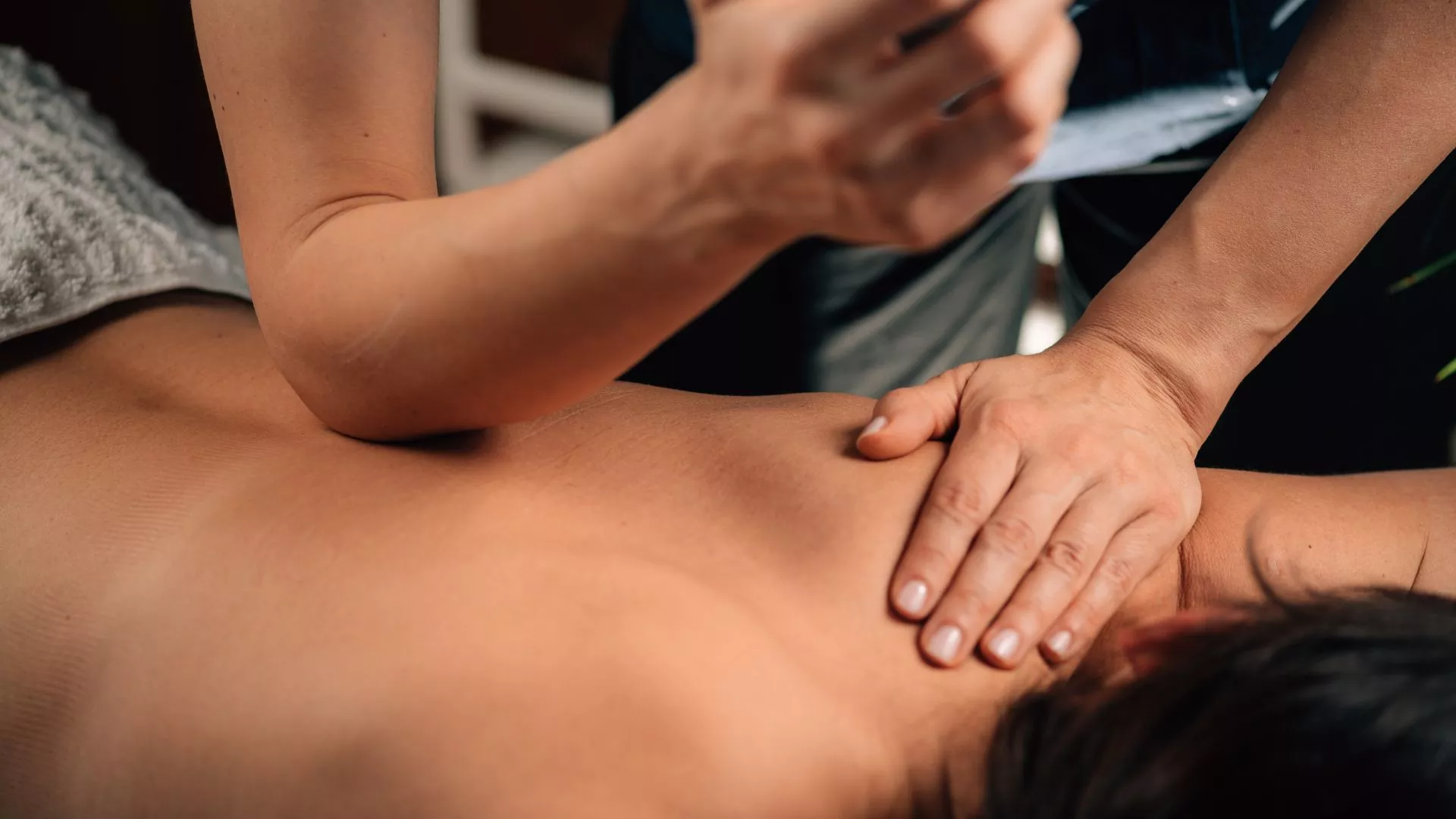
Deep tissue massage + Steam bath
Deep tissue massage is a therapeutic technique that targets inner layers of muscles and connective tissues to alleviate chronic pain and muscle tension. Through firm pressure and slow strokes, it aims to release muscle knots and improve flexibility, promoting overall relaxation and healing in specific areas of the body.
Deep tissue massage therapy is similar to Swedish massage, but the deeper pressure is beneficial in releasing chronic muscle tension. The focus is on the deepest layers of muscle tissue, tendons and fascia (the protective layer surrounding muscles, bones and joints).
Deep tissue massage is a therapeutic massage technique that focuses on addressing musculoskeletal issues and promoting overall relaxation. Unlike traditional massages, deep tissue massage targets the deeper layers of muscles, tendons, and fascia—the connective tissue surrounding muscles. This technique involves applying firm pressure and slow, deliberate strokes to reach the underlying structures.
The primary goal of deep tissue massage is to release tension and tightness in the body. It can be particularly beneficial for individuals with chronic pain, muscle injuries, or limited mobility. By targeting deeper layers of tissue, this massage aims to break down adhesions (knots) and realign muscle fibers, which can enhance flexibility and alleviate pain.
Deep tissue massage can be intense, and recipients may experience some discomfort during the session. However, the therapist works closely with the client to ensure the pressure is within their comfort level. It’s crucial for individuals to communicate with their massage therapist regarding any discomfort or pain to ensure a positive and effective experience.
Overall, deep tissue massage not only provides relief from physical tension but also promotes mental relaxation. It can improve circulation, reduce inflammation, and contribute to a sense of overall well-being. As with any massage therapy, individuals should consult with a healthcare professional before undergoing deep tissue massage, especially if they have pre-existing medical conditions.
Pain Relief: Deep tissue massage can effectively alleviate chronic pain by releasing tension and knots in the muscles. It is particularly beneficial for conditions such as lower back pain, neck and shoulder pain, and muscle stiffness.
Muscle Tension Release: The massage techniques used in deep tissue massage help to break down adhesions and knots in the muscles, promoting better flexibility and reducing muscle tension.
Improved Posture: Chronic muscle tension can contribute to poor posture. Deep tissue massage helps release tension in muscles and fascia, allowing the body to return to a more natural and aligned posture.
Injury Rehabilitation: Deep tissue massage is often used as part of rehabilitation from injuries, especially sports-related injuries. It aids in reducing inflammation, improving range of motion, and promoting faster healing.
Stress Reduction: While deep tissue massage is more intense than some other forms of massage, it can still contribute to overall relaxation. It helps in reducing stress hormones and promoting a sense of well-being.
Improved Blood Circulation: The massage techniques used in deep tissue massage can enhance blood flow to different parts of the body. Improved circulation can have positive effects on overall health and help with the removal of toxins from the muscles.
Breaks Down Scar Tissue: Deep tissue massage can help break down scar tissue that may have formed as a result of previous injuries. This can improve mobility and reduce pain associated with scar tissue.
Better Range of Motion: By releasing tension and improving flexibility in muscles and joints, deep tissue massage can contribute to an increased range of motion.
Reduction of Chronic Pain Conditions: Conditions such as fibromyalgia and arthritis can benefit from deep tissue massage as it helps manage pain and improve overall mobility.
Promotes Relaxation and Mental Well-being: Despite its intensity, deep tissue massage can have a calming effect on the nervous system, contributing to an overall sense of relaxation and mental well-being.

Thai Massage + Steam bath
Thai massage is a traditional healing art originating from Thailand that combines acupressure, assisted yoga poses, and passive stretching. Practitioners use hands, thumbs, elbows, and feet to apply rhythmic pressure and facilitate energy flow. It promotes relaxation, flexibility, and balance, enhancing overall well-being.
The traditional Thai massage is different from Western massages as it mainly focuses on circulation and pressure points, which help promote internal health and heal many symptoms caused from cramped muscles. This classic Thai massage is also known as Thai Yoga massage as the recipient will be placed on a mattress on the floor and the practitioner will use his or her whole body from hands, knees, legs to feet to stretch the muscles and release pressure from the body.
Thai massage, also known as Nuad Bo-Rarn, is a traditional therapeutic practice that originated in Thailand. Rooted in the ancient principles of Ayurveda and yoga, Thai massage is a unique blend of acupressure, assisted yoga postures, and energy balancing. Unlike many Western massage techniques that involve passive relaxation, Thai massage is an interactive and dynamic form of bodywork.
In a typical Thai massage session, the recipient lies on a comfortable mat on the floor, while the practitioner uses a combination of gentle stretching, compression, and rhythmic pressure to stimulate energy flow and promote overall well-being. The therapist uses their hands, thumbs, elbows, knees, and feet to apply pressure along energy lines and release tension in the body.
One key aspect of Thai massage is its emphasis on the concept of “sen” or energy pathways. The practitioner focuses on clearing blockages along these pathways to restore the balance of energy, known as “lom,” throughout the body. The stretches and movements incorporated in Thai massage aim to improve flexibility, joint mobility, and circulation.
Thai massage is not only a physical practice but also a meditative and spiritual one. Both the giver and receiver engage in a deep sense of mindfulness, creating a holistic experience that addresses the body, mind, and spirit. The therapeutic benefits of Thai massage include stress reduction, increased vitality, and a sense of relaxation and rejuvenation. As a cultural treasure with centuries of history, Thai massage continues to be a popular and revered form of healing and self-care around the world.
Improved Flexibility: Thai massage involves a variety of stretching techniques, which can help improve flexibility by targeting different muscle groups and joints.
Stress Relief: Like many forms of massage, Thai massage can help reduce stress and promote relaxation. The combination of rhythmic compressions and stretches can induce a sense of calm and well-being.
Enhanced Energy Flow: Thai massage is based on the concept of energy lines or “sen” in traditional Thai medicine. The massage aims to unblock energy flow along these lines, promoting balance and harmony within the body.
Pain Relief: The acupressure techniques used in Thai massage can help relieve muscular tension and joint pain. It may be beneficial for individuals dealing with chronic pain conditions.
Improved Circulation: The combination of compression and stretching in Thai massage can stimulate blood circulation, promoting better oxygenation of tissues and the removal of waste products.
Increased Range of Motion: Regular Thai massage sessions can contribute to increased joint mobility and range of motion. This can be particularly beneficial for individuals with stiffness or restricted movement.
Muscle Relaxation: The various massage techniques applied during a Thai massage session can help relax tense muscles, reducing muscle spasms and discomfort.
Balanced Body and Mind: Thai massage is often seen as a holistic approach that not only addresses physical tension but also aims to balance the energy flow, promoting a sense of harmony between the body and mind.
Enhanced Body Awareness: The recipient of Thai massage is often guided through passive yoga-like stretches, increasing body awareness and promoting mindfulness.
Boosted Immune System: Some proponents believe that the stimulation of energy lines and improved circulation in Thai massage can have positive effects on the immune system, although scientific evidence in this regard may be limited.

Marma massage + Steam bath
Marma massage is an ancient Indian healing technique that involves applying gentle pressure to specific energy points (marma points) on the body. This therapy aims to balance energy flow, promote relaxation, and enhance overall well-being by stimulating vital life force and relieving tension.
Marma massage is an ancient Indian practice that involves applying pressure to specific energy points or “marma” points on the body. These points are believed to be vital areas where energy pathways converge. While scientific research on Marma massage is limited, some potential benefits have been suggested based on traditional beliefs and anecdotal evidence. It’s important to note that individual experiences may vary, and more research is needed to establish scientific validity.
Marma massage is a traditional healing practice originating from Ayurveda, the ancient Indian system of medicine. The term “Marma” refers to vital energy points in the body, which are believed to be junctions where various tissues, such as muscles, veins, ligaments, and bones, meet. There are 107 Marma points distributed throughout the body, each associated with specific functions and organs.
During a Marma massage, practitioners apply gentle pressure, circular motions, and sometimes herbal oils to stimulate these vital points. The objective is to balance the flow of energy (prana) within the body, promoting physical, mental, and emotional well-being. This therapeutic massage technique not only addresses physical tension but also aims to enhance the body’s natural healing abilities.
Marma massage is deeply rooted in Ayurvedic principles, viewing the body as a holistic system where the balance of energies is crucial for maintaining health. The practice is believed to release blocked energy, improve circulation, and alleviate stress, leading to improved overall vitality. Additionally, Marma massage is thought to enhance the body’s self-healing mechanisms and support the removal of toxins.
Beyond its physical benefits, Marma massage is often praised for its potential to promote mental clarity, emotional balance, and spiritual well-being. The combination of precise touch and a focus on vital energy points distinguishes Marma massage as a holistic approach to health and wellness deeply embedded in the rich tapestry of Ayurvedic tradition.
Energetic balance: Marma massage is believed to help balance the flow of energy (prana) in the body. Stimulating marma points may release blocked energy and promote a sense of vitality.
Stress reduction: Like many forms of massage, Marma massage may help relax the body and mind, potentially reducing stress and promoting a sense of calm.
Improved circulation: Gentle manipulation of marma points could enhance blood circulation, promoting better oxygen and nutrient delivery to tissues throughout the body.
Detoxification: Some proponents suggest that Marma massage can aid in the removal of toxins from the body by promoting better circulation and lymphatic drainage.
Pain relief: The stimulation of certain marma points may help alleviate pain and discomfort in specific areas of the body. This is often associated with the release of blocked energy or tension.
Enhanced flexibility: Regular Marma massage may contribute to improved flexibility and joint mobility by reducing muscle tension and promoting relaxation.
Emotional well-being: Marma massage is thought to have a positive impact on mental and emotional well-being by promoting relaxation and balance. Some people report improved mood and a sense of clarity after a session.
Improved sleep: Relaxation induced by Marma massage may contribute to better sleep quality for some individuals.
Skin health: The gentle massage techniques used in Marma massage may promote healthier skin by improving blood flow and stimulating natural oil production.

Medical massage + Steam bath
Medical massage is a targeted therapeutic approach aimed at addressing specific health conditions or injuries. It involves the application of various massage techniques to alleviate pain, improve circulation, and enhance overall well-being under the guidance of a healthcare professional, often prescribed as part of a treatment plan.
The traditional Medeical Massage is different from Western massages as it mainly focuses on circulation and pressure points, which help promote internal health and heal many symptoms caused from cramped muscles. This classic Thai massage is also known as Thai Yoga massage as the recipient will be placed on a mattress on the floor and the practitioner will use his or her whole body from hands, knees, legs to feet to stretch the muscles and release pressure from the body.
Medical massage is a therapeutic approach to massage therapy that is focused on addressing specific health conditions and promoting overall well-being. Unlike relaxation or spa massages, medical massage is administered with the intent of achieving targeted outcomes related to a patient’s medical needs. It involves the application of various manual massage techniques to treat specific musculoskeletal issues, alleviate pain, and improve functional mobility.
The practice of medical massage is often informed by a thorough assessment of the patient’s medical history, physical condition, and any existing health concerns. The massage therapist may work closely with other healthcare professionals to ensure a coordinated and comprehensive approach to the patient’s care.
Medical massage techniques may include deep tissue massage, trigger point therapy, myofascial release, and other modalities that aim to address soft tissue problems and improve circulation. Conditions commonly treated with medical massage include chronic pain, injuries, postural imbalances, and musculoskeletal disorders.
Beyond its physical benefits, medical massage can also contribute to stress reduction and relaxation, thereby supporting the body’s natural healing processes. It is important to note that medical massage should be performed by qualified and licensed massage therapists who have received specialized training in the application of these techniques for therapeutic purposes.
Overall, medical massage is a valuable component of integrative healthcare, providing a non-invasive and drug-free approach to managing certain health conditions and promoting holistic well-being.
Muscle Relaxation: The combination of massage and steam can help relax tight muscles. Massage helps release muscle tension, while the heat from the steam bath can further soothe and relax muscles.
Improved Circulation: Massage increases blood flow to the treated areas, and the heat from a steam bath can dilate blood vessels, enhancing overall circulation. Improved circulation can contribute to better oxygen and nutrient delivery to tissues and organs.
Joint Mobility: Massage can increase joint flexibility and range of motion. When combined with the warmth of a steam bath, joints may become more pliable, potentially reducing stiffness and promoting better mobility.
Detoxification: Sweating induced by the steam bath helps eliminate toxins from the body. This, coupled with the circulatory benefits of massage, can support the body’s natural detoxification processes.
Stress Reduction: Both massage and steam baths have proven stress-relieving effects. Massage promotes the release of endorphins, while the heat from the steam bath can induce relaxation, leading to a reduction in stress levels.
Pain Management: Medical massage is often used to manage pain conditions such as muscle aches, joint pain, or headaches. The combination with a steam bath may enhance pain relief by addressing both muscular and systemic factors.
Improved Sleep: The relaxation induced by the massage and steam bath combination can contribute to better sleep quality. Reduced muscle tension and stress levels may help individuals achieve a more restful night’s sleep.
Skin Health: Steam baths can open pores and promote sweating, which can contribute to clearer skin. The increased circulation from the massage may also support healthier skin.
Enhanced Mood: The release of endorphins during a massage, combined with the calming effects of a steam bath, can positively impact mood and contribute to an overall sense of well-being.
Immune System Support: Some studies suggest that regular massage and heat therapy may have positive effects on the immune system, potentially boosting immune function.
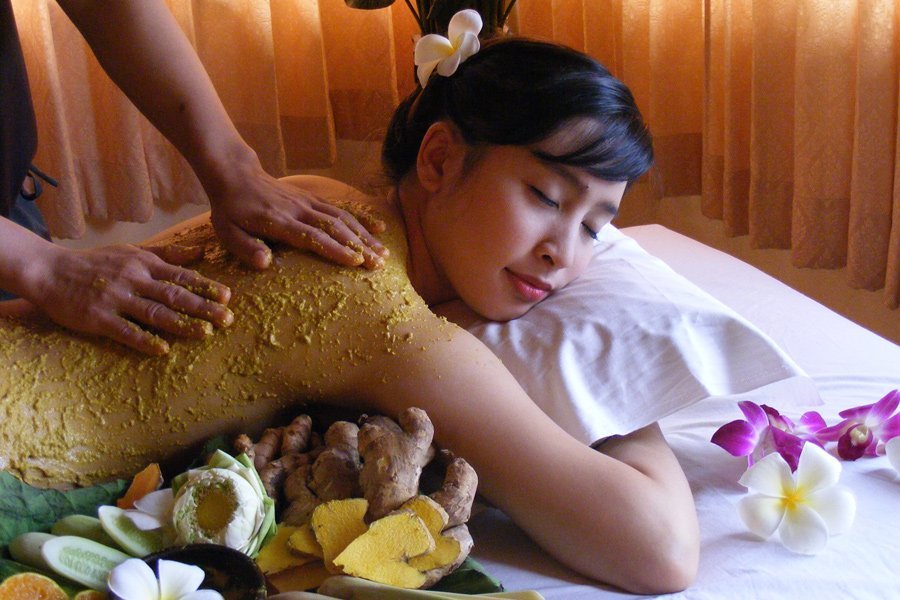
Scrub Massage + Steam bath
A scrub massage involves exfoliating the skin using abrasive substances, such as salt, sugar, or coffee grounds, mixed with oils or lotions. This therapeutic treatment helps remove dead skin cells, stimulate circulation, and promote a smoother, rejuvenated complexion, leaving the skin feeling refreshed and revitalized.
Body scrubs eliminate dead skin cells, facilitate proper blood circulation, prevent ingrown hair and cleanse your skin via exfoliation. A scrub massage is a type of spa treatment where a good quality of scrub is utilized instead of the conventional massage oil. The scrub has many other advantages that can help you attain your full skin potential.
A scrub massage, also known simply as a scrub or exfoliating massage, is a spa or skincare treatment that involves the application of a granular substance to the skin to remove dead cells and promote skin rejuvenation. This therapeutic practice combines the benefits of both exfoliation and massage to enhance the skin’s texture, appearance, and overall health.
During a scrub massage, a specially formulated scrub or exfoliating product is gently massaged onto the skin in circular motions. The scrub typically contains abrasive particles such as sugar, salt, coffee grounds, or other natural exfoliants. These granules work to slough off dead skin cells, unclog pores, and stimulate blood circulation. The massaging action not only aids in the physical removal of impurities but also promotes relaxation and stress relief.
The scrub massage offers various skin-related benefits. Exfoliation helps to improve skin tone, reduce the appearance of fine lines and wrinkles, and promote a smoother complexion. Additionally, it can enhance the absorption of moisturizers and other skincare products, maximizing their effectiveness.
Different types of scrubs may cater to specific skin types or concerns, such as sensitive skin or conditions like acne. Additionally, the choice of scrub ingredients can contribute to additional therapeutic effects, such as the invigorating aroma of essential oils or the antioxidant properties of certain natural extracts.
Ultimately, a scrub massage provides a holistic approach to skincare, combining the physical exfoliation of dead skin cells with the soothing and revitalizing aspects of massage, resulting in a rejuvenated and radiant skin appearance.
1. Skin Exfoliation:
- Scrub massage helps in removing dead skin cells, promoting smoother and softer skin.
- Exfoliation can unclog pores and prevent the formation of acne and other skin blemishes.
2. Improved Circulation:
- The massaging action increases blood circulation, which can contribute to better nutrient and oxygen delivery to the skin cells.
3. Relaxation and Stress Relief:
- The massage can help in releasing muscle tension and promoting relaxation.
- A steam bath is known to have a calming effect on the nervous system, contributing to stress relief.
4. Detoxification:
- Steam baths induce sweating, which aids in the removal of toxins from the body through the skin.
- Scrubbing also helps in cleansing the skin, supporting the body’s natural detoxification processes.
5. Hydration:
- Scrubbing followed by a steam bath can open up pores, allowing for better absorption of moisturizers or lotions, leading to improved skin hydration.
6. Skin Rejuvenation:
- The combination of exfoliation and steam can stimulate cell turnover, promoting the regeneration of new, healthy skin cells.
7. Improved Skin Tone:
- Regular scrub massages and steam baths can contribute to a more even skin tone by reducing pigmentation and dark spots.
8. Relaxation for Muscles and Joints:
- The heat from a steam bath can help soothe sore muscles and joints, providing relief from stiffness and discomfort.
9. Enhanced Product Absorption:
- After scrubbing and opening up the pores through steam, the skin is more receptive to the absorption of skincare products, maximizing their effectiveness.
10. Respiratory Benefits:
- Steam inhalation during a steam bath can be beneficial for respiratory health by helping to clear nasal passages and alleviate congestion.

Head & Foot Massage + Steam bath
Head & Foot Massage involves therapeutic techniques applied to the head and feet to promote relaxation and well-being. It utilizes gentle pressure, kneading, and circular motions to release tension, improve circulation, and alleviate stress. This holistic approach enhances overall comfort and induces a sense of tranquility.
Head and foot massage is a therapeutic practice that involves the application of pressure and manipulation techniques to the head and feet to promote relaxation, alleviate stress, and improve overall well-being. This holistic approach recognizes the interconnectedness of the body and aims to balance the energy flow throughout.
In head massage, also known as Indian head massage or scalp massage, practitioners use gentle and rhythmic movements to knead and stimulate the scalp, neck, and face. This not only helps to release tension in the muscles but also enhances blood circulation, which can contribute to improved hair and scalp health. The calming effects of head massage extend beyond the physical realm, providing mental relaxation and reducing headaches and anxiety.
Foot massage, on the other hand, involves applying pressure to specific points on the feet, which correspond to different organs and systems in the body according to reflexology. By stimulating these reflex points, practitioners aim to promote balance and harmony within the body. Foot massage is known to enhance circulation, relieve pain, and induce a deep sense of relaxation.
Combining head and foot massage in a single session offers a comprehensive and rejuvenating experience. It targets key areas associated with stress and tension, providing a holistic approach to relaxation. Whether as part of a spa treatment or a standalone therapy, head and foot massage can contribute to overall health and wellness, leaving individuals feeling revitalized and centered.
Head Massage Benefits:
- Stress Relief: Head massages can help release tension and reduce stress. The scalp has many pressure points that, when massaged, can trigger a relaxation response.
- Improved Blood Circulation: Gentle massage on the scalp can enhance blood circulation, promoting better oxygen and nutrient delivery to the hair follicles and brain.
- Headache and Migraine Relief: Massaging the temples, neck, and scalp can alleviate tension headaches and migraines by relaxing the muscles and reducing muscle spasms.
- Better Sleep: Head massages can induce a sense of calmness and relaxation, potentially improving sleep quality by reducing stress and anxiety.
- Hair Health: Stimulating the scalp can improve the health of the hair follicles and may contribute to healthier hair growth.
- Increased Mental Alertness: A head massage can help enhance mental alertness and concentration by promoting better blood flow and reducing mental fatigue.
Foot Massage Benefits:
- Stress Reduction: Like head massages, foot massages can help relieve stress and promote relaxation. There are numerous pressure points on the feet connected to various organs and systems in the body.
- Improved Circulation: Foot massages can stimulate blood flow, which is essential for the transportation of oxygen and nutrients to cells throughout the body.
- Pain Relief: Foot massages may alleviate pain and discomfort associated with conditions such as plantar fasciitis, arthritis, or general foot fatigue.
- Better Sleep: Just like head massages, foot massages can contribute to better sleep by promoting relaxation and reducing stress levels.
- Enhanced Mood: The release of endorphins during a foot massage can contribute to an improved mood and a sense of well-being.
- Reduced Swelling: For those dealing with conditions that cause swelling in the feet, such as edema, a gentle foot massage may help reduce fluid retention.
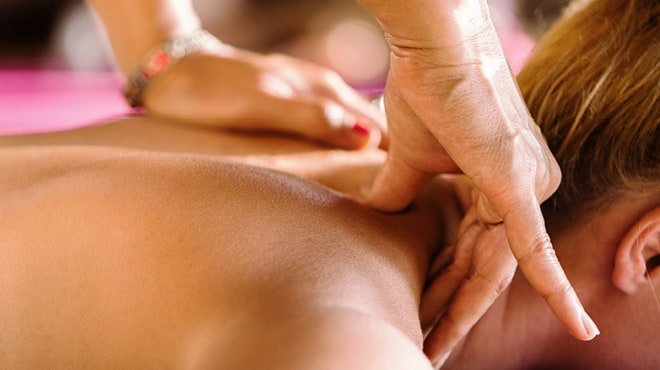
Neck & Back Massage + Steam bath
A neck and back massage involves therapeutic manipulation of muscles in the neck and back regions to alleviate tension, reduce stress, and enhance relaxation. Skilled practitioners use various techniques to release knots, improve circulation, and promote overall well-being, offering relief from discomfort and promoting a sense of calm.
The traditional Thai massage is different from Western massages as it mainly focuses on circulation and pressure points, which help promote internal health and heal many symptoms caused from cramped muscles. This classic Thai massage is also known as Thai Yoga massage as the recipient will be placed on a mattress on the floor and the practitioner will use his or her whole body from hands, knees, legs to feet to stretch the muscles and release pressure from the body.
A “Neck & Back Massage” is a therapeutic technique designed to alleviate tension and promote relaxation in the neck and back regions of the body. This type of massage targets specific areas that commonly harbor stress, discomfort, and muscle tightness. Skilled massage therapists employ various techniques such as kneading, stroking, and applying pressure to release knots and tightness in the muscles.
The neck and back are prone to accumulating stress due to factors like poor posture, sedentary lifestyles, and repetitive movements. A Neck & Back Massage aims to address these issues by increasing blood circulation, reducing muscle stiffness, and enhancing flexibility. The therapist may use their hands, fingers, elbows, or even specialized tools to apply varying degrees of pressure, tailored to the individual’s preferences and needs.
Beyond the physical benefits, a Neck & Back Massage can have positive effects on mental well-being. The soothing touch and manipulation of muscles contribute to stress reduction, promoting a sense of calm and relaxation. Clients often experience improved mood and a release of built-up tension.
Regular sessions of Neck & Back Massage can be a valuable component of a holistic approach to wellness, contributing to overall physical and mental health. Whether seeking relief from chronic pain, relaxation, or preventive care, individuals can benefit from the targeted and rejuvenating effects of a Neck & Back Massage.
Muscle Relaxation: Massage helps to relax tight muscles in the neck and back, reducing muscle tension and promoting overall relaxation. This can alleviate discomfort and improve flexibility.
Pain Relief: Massage can be effective in reducing pain, especially for individuals experiencing chronic neck or back pain. It helps to release endorphins, the body’s natural painkillers.
Improved Circulation: The kneading and stroking motions during a massage promote better blood circulation. Improved circulation enhances the delivery of oxygen and nutrients to the muscles and accelerates the removal of waste products.
Posture Enhancement: Regular massages can contribute to better posture by addressing muscular imbalances and reducing tension. Improved posture, in turn, can help prevent future strain and discomfort.
Stress Reduction: Neck and back massages are known for their stress-relieving benefits. The physical touch and relaxation induced by massage stimulate the release of serotonin and dopamine, promoting a sense of well-being.
Reduced Anxiety and Depression: Massage therapy has been linked to reductions in anxiety and depression levels. The calming effect of massage can positively impact mental health and contribute to a more balanced emotional state.
Enhanced Range of Motion: By addressing muscle stiffness and promoting flexibility, massages can lead to an increased range of motion. This is particularly beneficial for individuals dealing with conditions like arthritis.
Improved Sleep Quality: Regular massages have been associated with better sleep patterns. The relaxation induced by massage can help those struggling with insomnia or irregular sleep.
Boosted Immune System: Some studies suggest that regular massages may have a positive impact on the immune system by increasing the activity of natural killer cells and improving overall immune function.
Headache Relief: Neck and back massages can help alleviate tension headaches and migraines by reducing muscle tension in the head, neck, and shoulder areas.
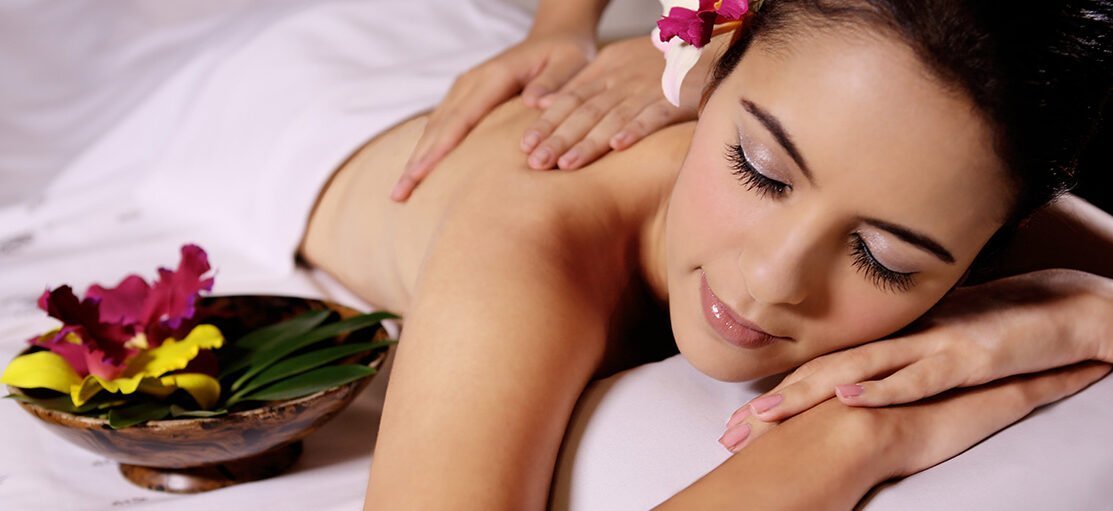
Honey Rose Massage
Rose honey massage involves applying a blend of rose oil and honey to the skin, combining the therapeutic benefits of roses and the moisturizing properties of honey. The massage promotes relaxation, nourishes the skin, and may enhance circulation, leaving a soothing and fragrant experience.
This is also known as “SHAHI SANAN” in which we use fresh Rose petals crushed in pure cow milk and mixed with honey.
Rose Honey Massage is a luxurious and rejuvenating spa therapy that combines the therapeutic benefits of rose oil and honey to provide a sensory experience that promotes relaxation and skin nourishment. This indulgent massage technique integrates the aromatic essence of roses and the moisturizing properties of honey, creating a blissful treatment for both the body and mind.
The therapy typically begins with a gentle application of warm rose oil, extracted from the petals of the rose flower, which is known for its calming and uplifting fragrance. The oil is carefully massaged onto the skin, allowing its aromatic compounds to evoke a sense of tranquility and emotional well-being. Rose oil is also celebrated for its potential to promote skin health, with its natural anti-inflammatory and antioxidant properties.
Moisturizing: Honey is known for its moisturizing properties. It can help hydrate the skin, making it feel soft and smooth. Rose oil or rose water also has hydrating effects on the skin.
Antioxidant Properties: Both honey and rose contain antioxidants that may help protect the skin from damage caused by free radicals. This can contribute to anti-aging effects.
Anti-Inflammatory: Honey and rose may have anti-inflammatory properties that can help soothe irritated skin and reduce redness.
Aromatherapy: The scent of rose is often associated with relaxation and can have aromatherapeutic benefits. A massage with rose oil may contribute to a sense of calm and well-being.
Gentle Exfoliation: Honey has natural exfoliating properties that can help remove dead skin cells, leaving the skin looking refreshed and glowing.
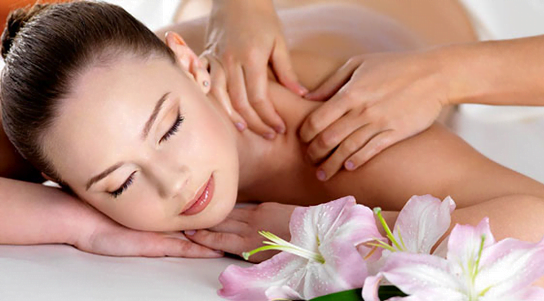
Back, Neck & Shoulder Massage
A Back, Neck & Shoulder Massage is a therapeutic treatment focusing on relieving tension and stress in these specific areas. Using various techniques, such as kneading and pressure-point massage, it aims to promote relaxation, alleviate muscle discomfort, and enhance overall well-being.
A “Back, Neck & Shoulder Massage” is a therapeutic massage specifically designed to target and alleviate tension, discomfort, and stress in the upper body. This specialized massage technique focuses on the back, neck, and shoulders – areas that commonly harbor muscular tightness and knots due to factors like poor posture, sedentary lifestyles, or stress.
During the massage, a skilled therapist employs various manual manipulation techniques, such as kneading, rubbing, and applying pressure, to release muscle tension and promote relaxation. The therapist may use their hands, fingers, elbows, and even forearms to work on specific muscles and trigger points in the targeted areas.
This massage offers numerous benefits, including improved blood circulation, reduced muscle stiffness, and enhanced flexibility. By addressing the muscles in the back, neck, and shoulders, it can also contribute to alleviating headaches, neck pain, and discomfort associated with prolonged sitting or standing.
Beyond the physical benefits, a Back, Neck & Shoulder Massage is known for its ability to induce a sense of relaxation and mental well-being. The release of tension in these areas often leads to an overall feeling of comfort and stress relief. Clients often find this massage to be a revitalizing experience, helping them unwind and rejuvenate both physically and mentally.
In summary, a Back, Neck & Shoulder Massage is a therapeutic session tailored to relieve tension and promote relaxation in specific areas of the upper body, offering a holistic approach to physical and mental well-being.
- Improved Circulation: Massage promotes better blood circulation, which can enhance the delivery of oxygen and nutrients to muscles.
- Flexibility: It can help improve the range of motion and flexibility in the targeted areas.
- Stress Relief: Massage has a calming effect on the nervous system, reducing stress and promoting a sense of well-being.
- Pain Management: It may provide relief from chronic pain or discomfort in the back, neck, and shoulders.

Shirodhara
Shirodhara is a traditional Ayurvedic therapy involving the gentle pouring of warm oil or other liquids onto the forehead, specifically the “third eye” area. This soothing and therapeutic technique aims to promote relaxation, balance the mind, and alleviate stress by harmonizing the flow of vital energy in the body.
Shirodhara is a traditional Ayurvedic therapy that originated in India and has been practiced for centuries. The word “Shirodhara” is derived from the Sanskrit words “shiro,” meaning head, and “dhara,” meaning flow. This therapeutic procedure involves a continuous and rhythmic pouring of warm, herbal oil or other liquids onto the forehead or the “third eye” region, positioned at the center of the forehead.
The treatment is performed with the individual lying down comfortably, and a specialized vessel called a “dhara pot” is suspended above the forehead. The liquid flows gently in a steady stream, inducing a deep sense of relaxation and promoting mental clarity. The choice of liquid can vary, and it may include herbal oils, medicated milk, buttermilk, or even water infused with herbs, depending on the individual’s specific needs and the desired therapeutic effect.
Shirodhara is renowned for its ability to alleviate stress, anxiety, and insomnia, as the continuous flow of liquid induces a meditative state and calms the nervous system. The warm oil nourishes the scalp, hair, and nervous tissues, contributing to overall well-being. Additionally, Shirodhara is believed to balance the doshas – Vata, Pitta, and Kapha – which are fundamental principles in Ayurveda governing various physiological and psychological functions.
This ancient Ayurvedic therapy is not only a holistic approach to mental and emotional well-being but also promotes physical health by addressing imbalances in the body’s energy systems. Shirodhara is considered a rejuvenating and revitalizing practice that brings harmony to the mind, body, and spirit.
- Relaxes mind & body.
- Increases energy.
- Improves healing.
- Treats insomnia & Promotes sound sleep.
- Nourishes hair & skin
- Improves concentration.
- Reduces anxiety & stress.
- Treats memory problems.
- Deep relaxing of the nervous system.
- Improved function of the 5 senses.
- Relief for the mental and physical stress and strain.
- Increased blood circulation around the body to the brain.
- Bost immunity.
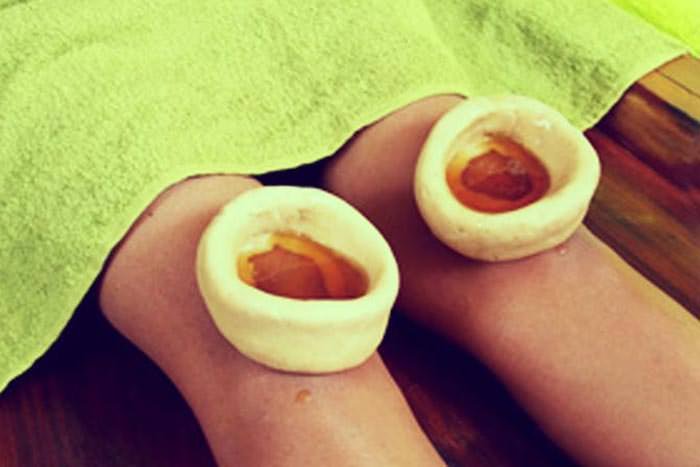
Janu Basti
Janu Basti is a traditional Ayurvedic therapy involving the application of medicated oils and herbal pastes to the knee joint. A dough dam is created on the knee, and warm oil is poured and retained within it. This treatment aims to alleviate knee pain, stiffness, and promote joint health.
Janu Basti is a hot oil therapy in which the hot oil is filled in an artificially made pit on the knees. The oil is chosen as per the condition and symptoms; this therapy is used in the treatment of knee.
Basthi means to stay in place inside, or that which is retained. Janu means Knee. Basti given on both knee areas is called as Janu basti.
In this therapy a dough ring is formed on both the knee area made from urad flour (black lentil). Warm Ayurveda oil is poured in that it to create like a pool. When the oil cools down it is squeezed out with the help of cotton cloth and warm oil is poured again, and massaged over the area. It promotes the strength of the knee joint by improving the circulation, this procedure is repeated couple of times as per severity of symptoms
- The main effect of this therapy is to reduce pain
- Reduce inflammation and degeneration of tissues
- Enhanced production of lubrication inside joint.
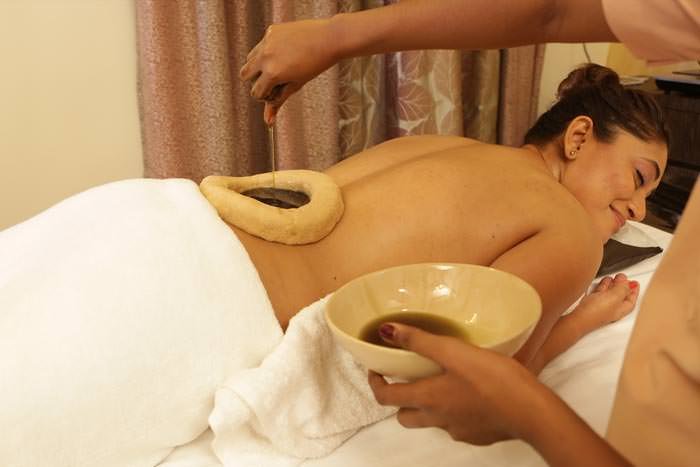
Kati Basti
Kati Basti is an Ayurvedic therapeutic procedure involving the application of medicated oil and dough around the lower back region. This treatment aims to alleviate pain and discomfort associated with conditions like lower back pain, sciatica, and spinal issues, promoting relaxation and improving the overall well-being of the individual.
Kati vasti is a highly effective treatment for back pain and spinal disorders. The waist area of the body is called Kati. Holding warm ayurvedic oils on the affected areas is called Vasti. Kati Vasti involves retention of specially prepared warm herbal oil over the lumbosacral area inside a dam made out of dough for certain period of time.
The temperature of oil is maintained reheating and continuously adding more oil. The oil is kept on for 30-45 minutes.
The hot medicated oils helps melt lower spine rigidity and strengthen your bone tissue. The healing properties of herbal oils used for kati vasti deeply clean and fortify the blood, build strong muscle and connective tissues, and lubricate the joints, joints keeping them flexible and pain free. Kati basti is likely to alleviate most types of low-back pain.
The treatment also helps to increase the blood circulation. It stimulates and nourishes nerves relieving pain and numbness. Also it strengthens back muscles which maintain normal curvature of the spine.
Relief from Lower Back Pain: Kati Basti is commonly used to alleviate lower back pain, stiffness, and discomfort. The warm oil helps to relax the muscles and reduce inflammation, providing relief from pain.
Improves Flexibility: The treatment involves holding a reservoir of warm oil on the lower back for a specific duration. This helps in improving the flexibility of the muscles and joints in the lower back region.
Nourishes the Spinal Discs: The warm medicated oil used in Kati Basti is believed to penetrate deep into the tissues, nourishing the spinal discs and promoting their health. This can be beneficial for conditions related to disc degeneration.
Enhances Circulation: The application of warm oil during Kati Basti may enhance blood circulation in the lower back area. Improved circulation can contribute to the overall health of the tissues and support the healing process.
Alleviates Sciatica Pain: Kati Basti is often recommended for individuals suffering from sciatica, as it can help reduce pain and discomfort associated with this condition. The warmth and therapeutic properties of the oil may have a soothing effect on the sciatic nerve.
Balances Vata Dosha: In Ayurveda, it is believed that many musculoskeletal issues, including lower back pain, are related to an imbalance of the Vata dosha. Kati Basti is thought to help balance Vata and bring about a sense of harmony in the body.
Promotes Relaxation and Stress Reduction: The warm oil and the massage techniques involved in Kati Basti contribute to relaxation. This can have a positive impact on reducing stress and promoting a sense of well-being.
Supports Overall Spinal Health: By addressing specific issues in the lower back, Kati Basti indirectly supports the overall health of the spine. This can be particularly beneficial for individuals dealing with chronic back problems.
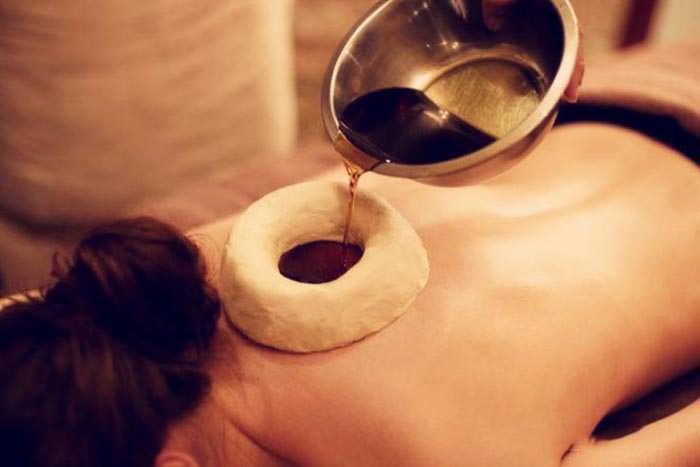
Greeva Basti
Greeva Basti is an Ayurvedic therapeutic procedure involving the application of medicated oil or herbal decoctions to the cervical region of the spine, specifically the neck. This treatment aims to alleviate pain, stiffness, and related issues in the neck and upper back, promoting overall musculoskeletal well-being.
This is a special Ayurvedic treatment for knee joint condition like arthritis including cervical spondylitis, I.V. disc prolepses, arthrosis etc. Bathing the neck region with warm medicated oil age-old treatment used to address acute and chronic neck conditions.
Greeva Basti is an Ayurvedic therapeutic procedure that involves the application of localized heat to the cervical (neck) region through the use of a specially designed reservoir made of dough, which holds medicated oil. This procedure is a part of Panchakarma, a comprehensive detoxification and rejuvenation therapy in Ayurveda, the traditional system of medicine in India.
The term “Greeva” refers to the neck or cervical region, and “Basti” means a container or reservoir. In Greeva Basti, a dough ring is created and placed around the neck area, forming a well-like structure. Warm medicated oil is then poured into this reservoir and allowed to remain in contact with the neck for a specified duration. The medicated oil used in Greeva Basti is typically prepared with herbs known for their anti-inflammatory, analgesic, and rejuvenating properties.
This therapeutic procedure is commonly employed to alleviate various conditions related to the neck and cervical spine, such as cervical spondylosis, stiffness, pain, and muscular spasms. The localized heat and the medicinal properties of the oil help in improving blood circulation, reducing inflammation, and nourishing the affected tissues. Greeva Basti is known for its efficacy in providing relief from neck-related discomfort, enhancing flexibility, and promoting overall well-being.
It is essential to undergo Greeva Basti under the guidance of a qualified Ayurvedic practitioner who can tailor the treatment to an individual’s specific needs and health condition.
- Helps relieve occasional neck pain and inflammation.
- Heals past injuries, inflammation and recurring neck pain, gently and effectively.
- Improves flexibility.
- Lubricates joints.
- Softens rigidity.
- Improves blood circulation.
- Helps heal compression fractures and frozen shoulders.

Hriday Basti
“Hriday Basti” is a term from Ayurveda, the ancient Indian system of medicine. It refers to a therapeutic procedure where a herbal paste is applied over the heart region and retained for a specific duration. This practice aims to promote cardiovascular health and balance the energy of the heart.
“Hriday Basti” is a term that combines two elements: “Hriday,” which translates to heart in Sanskrit, and “Basti,” which refers to a therapeutic enema or administration of medicinal substances. Together, the term denotes a traditional Ayurvedic treatment aimed at promoting heart health and well-being.
In Ayurveda, an ancient system of medicine originating in India, the heart is considered a vital organ connected to both physical and emotional well-being. Hriday Basti involves the administration of medicated oils or herbal decoctions through the rectum, with the intention of nourishing and strengthening the heart and cardiovascular system.
The procedure is part of the broader Panchakarma therapy, a detoxification and rejuvenation process in Ayurveda. During Hriday Basti, a specially prepared herbal oil or ghee is retained in the rectum for a specific duration, allowing the therapeutic properties of the substances to be absorbed into the bloodstream. This is believed to enhance the functioning of the heart, regulate blood circulation, and address imbalances in the cardiovascular system.
Ayurvedic practitioners recommend Hriday Basti for individuals dealing with heart-related issues, stress, anxiety, and emotional imbalances. However, it is crucial to note that Ayurvedic treatments should be administered by trained and qualified practitioners to ensure safety and effectiveness. As with any alternative therapy, individuals considering Hriday Basti should consult with healthcare professionals to integrate it safely into their overall wellness plan.
Detoxification: Basti therapies are thought to help in eliminating toxins from the body, promoting overall detoxification.
Balancing Doshas: Ayurveda emphasizes the balance of three doshas (Vata, Pitta, and Kapha). Basti treatments are often designed to balance these doshas and restore harmony.
Nourishment: Depending on the specific herbs and oils used in the enema, it may provide nourishment to the tissues and organs.
Relief from Certain Conditions: Ayurvedic practitioners might recommend Basti treatments for specific health issues, such as digestive disorders, joint problems, or reproductive system issues.

Shiro Vasti
Shiro Vasti is a traditional Ayurvedic therapy involving the application of medicated oil or herbal paste on the head and retaining it within a leather cap. This treatment aims to alleviate conditions like headaches, hair-related issues, and neurological disorders by promoting relaxation and nourishing the scalp.
Shiro Vasti is a traditional Ayurvedic therapeutic procedure that involves the application of medicated oil or herbal paste on the head and retaining it within a well-fitted cap for a specific duration. Derived from the Sanskrit words “Shiro” meaning head and “Vasti” meaning container or enclosure, this therapeutic technique is primarily designed to address various neurological and psychological disorders while promoting overall well-being.
The procedure begins with the application of a dough ring around the head, creating a reservoir-like structure. Warm herbal oil, often infused with Ayurvedic herbs, is then poured into this cap and allowed to stay on the head for a specified period. The oil penetrates the scalp and hair follicles, nourishing the tissues and promoting relaxation. The therapeutic benefits of Shiro Vasti extend beyond physical well-being to encompass mental and emotional health, as it is believed to have a calming effect on the nervous system.
Shiro Vasti is commonly recommended for conditions such as headaches, migraines, insomnia, stress, and various neurological disorders. The herbal oils used in the procedure are chosen based on their therapeutic properties, which may include anti-inflammatory, analgesic, and rejuvenating effects.
This Ayurvedic therapy is performed by trained practitioners in specialized Ayurvedic centers and is often integrated into comprehensive wellness programs aimed at restoring balance and harmony to the mind and body. As with any Ayurvedic treatment, it is essential to consult with a qualified Ayurvedic practitioner to determine the suitability of Shiro Vasti based on an individual’s unique constitution and health conditions.
- Shiro vasti stimulates specific points of the head & treats brain & neurological disorders including migraine, chronic headache, depression etc.
- Nourishes the brain.
- Lowers stress.
- Builds immunity against psychosomatic diseases.
- Helps to bring mental calmness.
- Nourishes the hair roots, makes the hair soft & glossy.
- Helps to cure various eye disorders, sinusitis.
- Treats various diseases like cervical spondylosis, numbness, facial paralysis, dryness of nose and mouth, cataract, deafness, earache and insomnia.

Netra Tarpan
Netra Tarpan is an Ayurvedic eye care therapy involving the gentle pouring of medicated ghee (clarified butter) around the eyes to nourish and rejuvenate them. This treatment aims to alleviate eye strain, improve vision, and promote overall eye health by balancing the doshas (biological energies) in the eyes.
Netra Tarpan, also known as “Tarpana” or “Netra Kriya,” is an Ayurvedic eye care therapy that holds roots in traditional Indian medicine. The term “Netra” refers to the eyes, and “Tarpan” means nourishment. Netra Tarpan involves a therapeutic process of rejuvenating and nourishing the eyes through a specific treatment.
During Netra Tarpan, a dough dam is created around the eyes using black gram paste, and medicated ghee (clarified butter) is poured into this reservoir. The ghee used in the treatment is enriched with various beneficial herbs and nutrients, selected based on the individual’s specific eye condition. The process typically lasts for a specific duration, allowing the eyes to absorb the nourishing qualities of the medicated ghee.
This Ayurvedic therapy aims to alleviate eye strain, dryness, and fatigue while promoting overall eye health. It is believed to enhance vision, reduce inflammation, and prevent various eye disorders. Netra Tarpan is often recommended for individuals experiencing conditions like computer vision syndrome, dry eyes, myopia, and other eye-related issues.
The herbal properties in the medicated ghee may vary, and practitioners tailor the treatment to address specific eye concerns. Regular sessions of Netra Tarpan are suggested for long-term eye care, and the therapy is considered a holistic approach to maintaining the health and well-being of the eyes in Ayurveda. It is crucial to consult with a qualified Ayurvedic practitioner before undergoing Netra Tarpan to ensure personalized and effective treatment.
- Rejuvenation: relaxing the eyes and strain reducing.
- Beauty: Improves eye glimmer.
- Therapeutic: relief from eye strain, redness of eyes, refractive errors, prevents cataract, eye disorders caused by pollution, or as prescribed by the doctor.
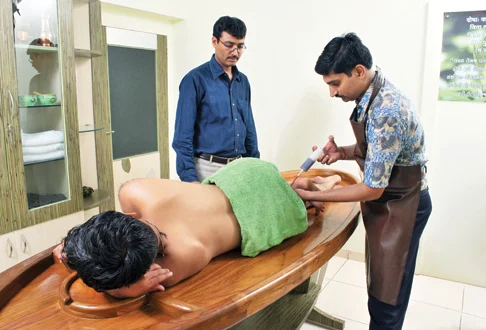
Enema (as per body condition)
An enema is a medical procedure involving the introduction of liquid into the rectum for therapeutic or cleansing purposes. It is commonly used to relieve constipation, administer medications, or prepare for certain medical procedures. The liquid helps soften stool and promote bowel movements by stimulating the intestines.
An enema is a medical procedure involving the introduction of fluid into the rectum and colon through the anus. This process is primarily used for therapeutic or diagnostic purposes, such as cleansing the bowels, administering medications, or facilitating certain medical examinations. Enemas have been employed for centuries, dating back to ancient civilizations, and continue to be utilized in modern medicine.
The primary goal of an enema is to stimulate bowel movements and promote the evacuation of feces. The procedure is often recommended to relieve constipation, prepare patients for certain medical procedures or surgeries, or assist in the removal of toxins from the body. The fluid introduced during an enema can vary, and commonly includes water, saline solution, or medicated solutions.
Enemas can be administered through different methods, including gravity-based systems, bulb syringes, or specialized enema bags. The choice of enema solution and method depends on the specific medical requirements and the healthcare professional’s recommendation.
While enemas are generally considered safe, they should be performed under the guidance of a qualified healthcare provider to ensure proper technique and minimize potential risks. It is crucial to follow medical advice and use enemas judiciously, as misuse or overuse may lead to electrolyte imbalances, dehydration, or irritation of the rectal tissues. Overall, enemas remain a valuable tool in healthcare for their role in promoting gastrointestinal health and addressing certain medical conditions.
- Matra Basti
- Kashaya Basti
- Ksheer Basti
- Shodan Basti
- Rejuvenation: detoxifying, nourishing.
- Beauty: glowing skin, eliminates acne.
- Therapeutic: Constipation, digestive track health, improves digestion, nurtures all body tissues, or as prescribed by the doctor.

Patra Potli
“Patra Potli” is a traditional Indian culinary delight. It consists of spiced colocasia leaves smeared with a gram flour paste, rolled into small parcels, and steamed or fried. This flavorful and nutritious dish is popular in the state of Gujarat, offering a unique blend of taste and texture.
“Patra Potli” is a traditional Indian culinary delight that translates to “leaf pouch” in English. This delectable dish is rooted in Indian cuisine, particularly in the states of Gujarat and Maharashtra. The name is derived from the Hindi word “Patra,” which means leaf, and “Potli,” which refers to a small pouch or bag.
The dish is made by coating colocasia leaves with a spiced gram flour (besan) paste and then rolling them into a cylindrical shape. These rolled leaves are steamed or sometimes deep-fried until they become firm and hold their shape. The result is a savory and flavorful snack that combines the earthy taste of colocasia leaves with the richness of the gram flour coating.
The gram flour mixture typically includes a blend of spices such as turmeric, red chili powder, asafoetida, and sesame seeds, creating a harmonious balance of flavors. Additionally, some regional variations may include grated coconut, tamarind pulp, or jaggery for added sweetness and tanginess.
Patra Potli is not only known for its delightful taste but also for its nutritional value. Colocasia leaves are rich in vitamins, minerals, and dietary fiber, making this snack a wholesome and healthy choice. Often served with chutneys or yogurt, Patra Potli has become a popular appetizer or tea-time treat, showcasing the diversity and creativity of Indian cuisine.
- Rejuvenation: relaxing, energizing and rejuvenating.
- Beauty: Nourishes and smoothens skin and tissues.
- Therapeutic: Improves general wellbeing, stimulates blood circulation, helps in insomnia or as prescribed by the doctor.
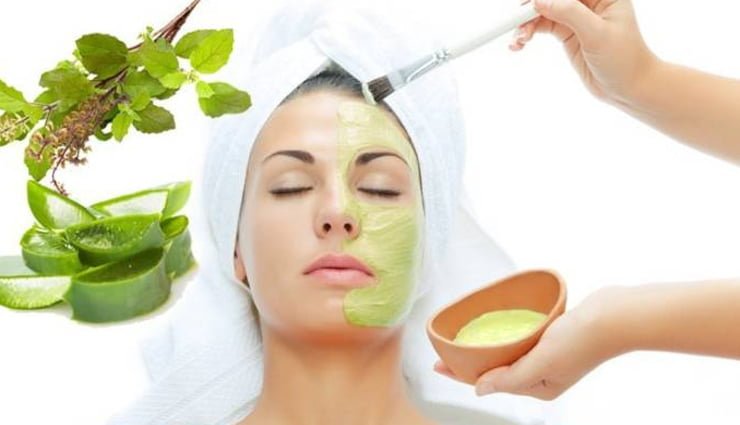
Ayurvedic Beauty Facial
Ayurvedic Beauty Facial is a holistic skincare practice rooted in traditional Ayurvedic principles. This ancient Indian approach incorporates natural ingredients and specialized techniques to promote balance and rejuvenation, enhancing skin health and overall well-being through personalized treatments tailored to one’s unique dosha (body-mind constitution).
An Ayurvedic Beauty Facial is a holistic and traditional approach to skincare deeply rooted in the ancient Indian system of Ayurveda. Ayurveda, which translates to “knowledge of life,” emphasizes a balance between mind, body, and spirit to achieve overall well-being. In the context of beauty, Ayurvedic facials focus on nurturing the skin through natural and personalized methods.
The Ayurvedic Beauty Facial typically begins with a thorough assessment of an individual’s unique constitution, known as their dosha (Vata, Pitta, or Kapha), to determine the most suitable skincare approach. This personalized aspect sets Ayurvedic facials apart from conventional beauty treatments.
The facial involves a combination of gentle cleansing, exfoliation, and nourishment using herbal and botanical ingredients specific to the person’s dosha. Commonly used herbs include turmeric, neem, sandalwood, and aloe vera, known for their skin-loving properties.
Ayurvedic facial massage, known as “mukha abhyanga,” is a key element. This massage stimulates marma points, vital energy centers related to skin health, promoting circulation and rejuvenation. Warm oils tailored to the individual’s dosha are often used, providing deep hydration and balancing effects.
The holistic nature of Ayurveda extends beyond physical benefits, aiming to harmonize the mind and emotions. This approach recognizes that inner well-being reflects outwardly on the skin. Ayurvedic Beauty Facials thus offer a comprehensive experience, promoting radiant skin while aligning with the principles of Ayurveda for overall harmony and balance.
- Rejuvenation: Rejuvenating and enlivening.
- Beauty: skin nourishing, brightens skin, helps the skin glow, anti-aging.
- Therapeutic: Stimulates blood circulation, removes acne, or as prescribed by the doctor.
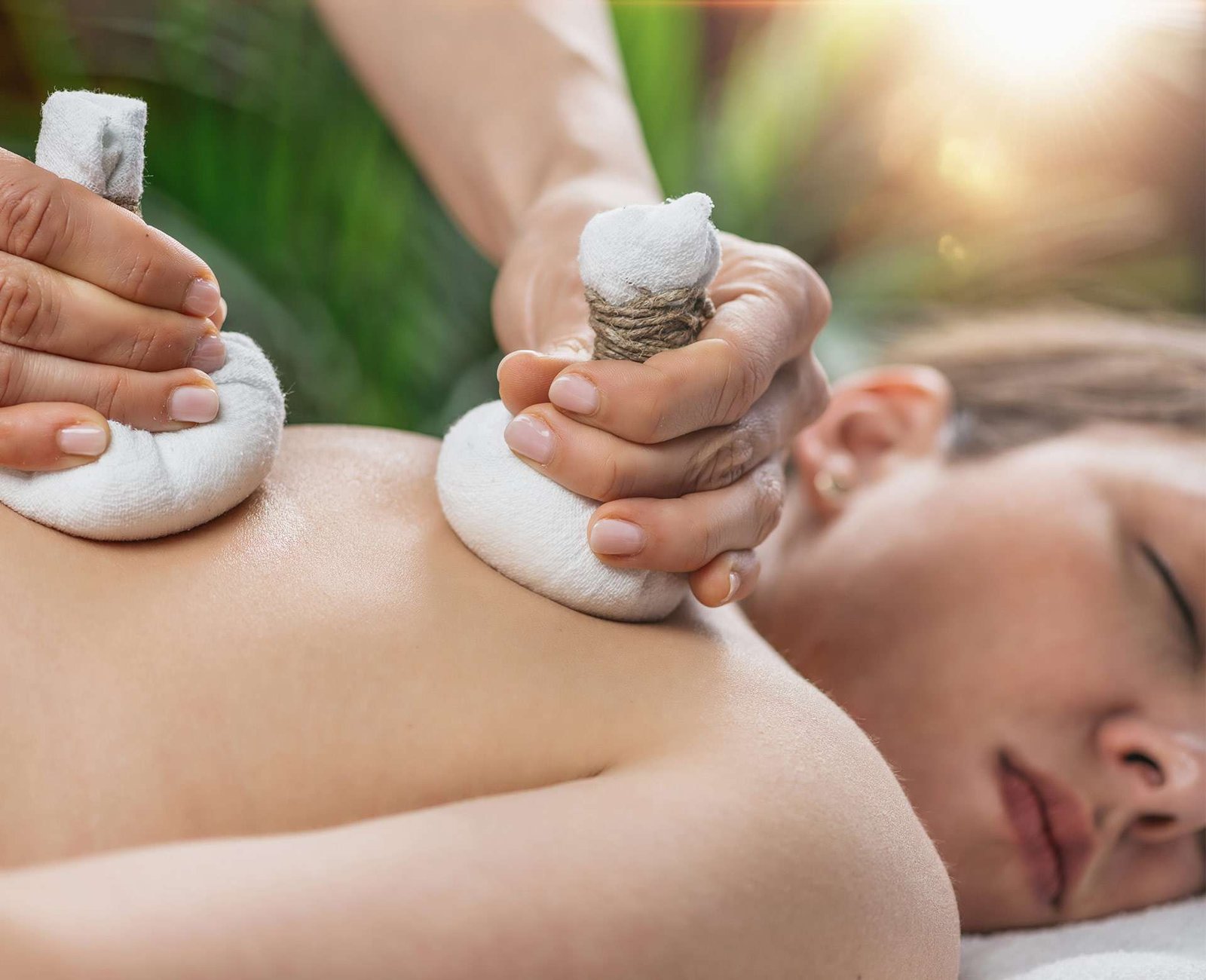
Choorna Swedan
Choorna Swedan is an Ayurvedic therapeutic procedure involving fomentation using medicinal powders. It promotes sweating, detoxifies the body, and alleviates pain and stiffness. The powdered mixture is heated and tied into boluses, then applied to the body, inducing perspiration and facilitating the expulsion of toxins for holistic well-being.
“Choorna Swedan” is a traditional Ayurvedic therapeutic procedure that involves the application of herbal powders (choorna) as a part of a therapeutic sweating or sudation therapy (swedan). Ayurveda, an ancient system of medicine originating in India, emphasizes the balance of doshas (biological energies) in the body for maintaining health. Choorna Swedan is employed to address various health conditions and promote overall well-being.
The procedure begins with the application of a specific herbal powder blend on the body, often mixed with medicated oils or ghee. The herbal powders used in Choorna Swedan are carefully chosen based on their therapeutic properties and the individual’s dosha constitution. The application is followed by a therapeutic sweating process, which may involve using a steam chamber or other modalities to induce sweating.
Choorna Swedan is believed to help eliminate toxins from the body, reduce inflammation, improve circulation, and alleviate various musculoskeletal conditions. The herbal powders used in the procedure can have a detoxifying and rejuvenating effect on the skin and tissues. Additionally, the warmth generated during the sweating process is thought to enhance the penetration of herbal properties, promoting a balancing effect on the doshas.
This Ayurvedic therapy is often recommended for conditions like arthritis, muscle pain, stiffness, and certain skin disorders. However, it is essential to undergo Choorna Swedan under the guidance of a qualified Ayurvedic practitioner who can customize the treatment based on individual health needs and doshic imbalances.
- Increases the peripheral blood supply.
- Alleviates body ache and strengthens the muscles.
- Reduces inflammation in joints.
- Relaxes the muscles and relieves joint stiffness.

Abhyanga Njvarakizhi (Herbal Rice Bolus)
Abhyanga Njvarakizhi is a traditional Ayurvedic therapy involving a therapeutic massage (Abhyanga) followed by the application of warm boluses filled with medicinal herbs and rice (Njvarakizhi). This rejuvenating treatment aims to promote relaxation, improve circulation, and alleviate muscle and joint discomfort.
Abhyanga Njvarakizhi, also known as Herbal Rice Bolus, is a traditional Ayurvedic therapy that originates from the ancient healing system of India. This therapeutic procedure combines the benefits of Abhyanga (oil massage) and Njvarakizhi (rice bolus massage) to promote physical and mental well-being.
The treatment begins with a full-body Abhyanga massage using warm medicated oils specifically chosen based on the individual’s dosha, or energy constitution, according to Ayurvedic principles. The massage is performed by skilled therapists to enhance circulation, relax muscles, and release accumulated toxins.
Following the Abhyanga massage, the Njvarakizhi component is introduced. In this phase, small linen pouches filled with a mixture of cooked medicinal rice, herbal powders, and herbs are applied to the body. These boluses are gently massaged over the body, providing a unique blend of heat, pressure, and herbal benefits. The warmth helps in opening the pores, allowing the therapeutic herbs to penetrate the skin and exert their healing properties.
Abhyanga Njvarakizhi is renowned for its ability to alleviate joint and muscle pain, reduce inflammation, enhance blood circulation, and promote relaxation. The medicinal properties of the herbs used in the rice bolus contribute to detoxification and rejuvenation. This holistic therapy aims to balance the doshas, promoting overall health and harmony within the body and mind. Regular sessions of Abhyanga Njvarakizhi are believed to support longevity and maintain optimal well-being in accordance with Ayurvedic principles.
- Rejuvenation: nourishing and strengthening
- Beauty: softens skin, enhances complexion
- Therapeutic: strengthening the nerves, restoring neurological balance, muscular atrophy, arthritis or as prescribed by the doctor.
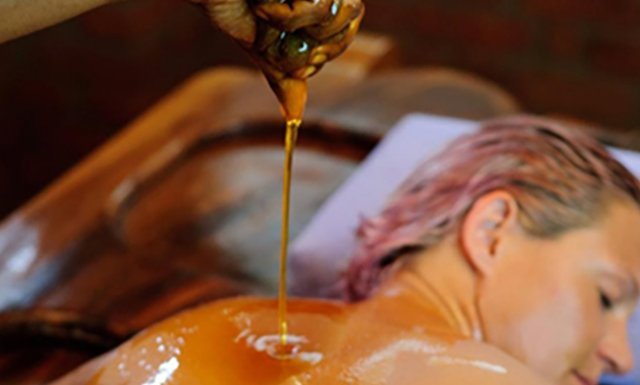
Pizhichil (Warm Oil Bath)
Pizhichil is a traditional Ayurvedic therapy involving the continuous pouring of warm medicated oil over the body, followed by gentle massage. This rejuvenating treatment helps alleviate stress, enhance circulation, and nourish the skin. Pizhichil is known for its therapeutic benefits and promoting overall well-being in Ayurveda.
Pizhichil, also known as “Sarvangadhara” in Ayurveda, is a traditional and therapeutic massage technique that originated in India. The term “Pizhichil” is derived from the Malayalam words “pizhichal,” which means “to squeeze,” and “il,” which means “with.” This unique form of treatment involves the continuous pouring of warm, medicated herbal oil over the entire body while simultaneously massaging it.
The process typically begins with a gentle massage to prepare the body, followed by the pouring of lukewarm medicated oil in a rhythmic manner. The oil used in Pizhichil is usually a combination of various herbs and is chosen based on the individual’s specific health needs. The temperature of the oil is carefully monitored to ensure it remains comfortably warm throughout the session.
Pizhichil is renowned for its rejuvenating and therapeutic effects. The warm oil penetrates the skin, nourishing the tissues and promoting relaxation. The rhythmic massage helps in stimulating the muscles, improving blood circulation, and relieving joint stiffness. Additionally, the medicinal properties of the herbal oils used in Pizhichil contribute to detoxification and balance of the doshas, which are fundamental principles in Ayurveda representing physiological and psychological aspects.
This ancient Ayurvedic therapy is often recommended for individuals with ailments such as arthritis, neurological disorders, and muscle-related issues. Pizhichil not only addresses physical health but also has a calming effect on the mind, making it a holistic approach to well-being in the realm of traditional Indian medicine.
- Rejuvenation: highly relaxing, nurturing and rejuvenating
- Beauty: slows down aging, glowing skin, complete detoxification
- Therapeutic: rheumatic diseases, arthritis, paralysis, slowing down aging, sexual weakness, neurological disorders, blood pressure, nervous weakness or as prescribed by the doctor.
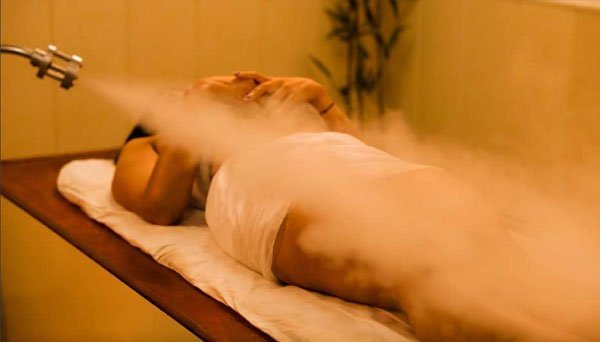
Nadi Swedan Ekang (Localized)
“Nadi Swedan Ekang (Localized)” refers to Ayurvedic localized steam therapy. In this treatment, steam is applied to specific body parts using a tube or pipe. It aims to promote relaxation, alleviate pain, and improve circulation by harnessing the therapeutic benefits of localized steam on targeted areas of the body.
“Nadi Swedan Ekang (Localized)” is a term rooted in Ayurveda, an ancient system of medicine that originated in India. Ayurveda emphasizes the balance of bodily energies, or doshas, for overall health and well-being. “Nadi” refers to the channels through which vital energy flows in the body, and “Swedan” translates to sweating or sudation therapy.
“Nadi Swedan Ekang” specifically involves localized sweating therapy. In Ayurveda, localized sweating is believed to help eliminate toxins, balance doshas, and promote healing in specific areas of the body. This therapy often employs the use of steam, herbal poultices, or medicated oils to induce sweating in targeted regions.
The term “Ekang” further specifies that this therapy is applied to a particular part or limb of the body. This focused approach allows practitioners to address localized issues such as joint pain, muscle stiffness, or inflammation in a more precise manner.
Ayurvedic therapies like Nadi Swedan Ekang are designed to restore harmony within the body, addressing imbalances that may contribute to various health issues. However, it’s essential for individuals to consult with qualified Ayurvedic practitioners to determine the most suitable therapies based on their unique constitution and health concerns. Ayurveda considers the individual’s unique mind-body constitution, known as “Prakriti,” and tailors treatments accordingly to promote holistic well-being.
- Rejuvenation: relaxing, detoxifying and cleansing.
- Beauty: skin nurturing, smoothens skin, detoxifying.
- Therapeutic: relieves oedema, stimulates blood circulation, removes muscular stiffness, inflammation of joints, or as prescribed by the doctor.

Nadi Swedan Sarvang (Full Body)
“Nadi Swedan Sarvang, or Full Body Steam Therapy, is an ancient Ayurvedic practice involving herbal steam treatment applied to the entire body. This detoxifying therapy aims to open energy channels (nadis), promoting relaxation, improving circulation, and eliminating toxins through perspiration for overall well-being and rejuvenation.”
Nadi Swedan Sarvang, also known as Full Body Steam Therapy, is a traditional Ayurvedic practice that involves the therapeutic application of steam to the entire body. Rooted in ancient Indian medicine, Ayurveda, Nadi Swedan Sarvang aims to promote holistic well-being by balancing the body, mind, and spirit.
The word “Nadi” in Sanskrit refers to the channels or pathways through which vital energy flows in the body, and “Swedan” means sweating or inducing sweat. This therapeutic procedure involves the controlled exposure of the entire body to steam, typically generated from herbal-infused water. The steam helps open up the body’s pores, allowing the elimination of toxins and impurities through sweat.
Herbs such as neem, eucalyptus, and mint are often added to the steam to enhance the therapeutic effects. The aromatic properties of these herbs contribute not only to the physical benefits but also to the overall relaxation and rejuvenation of the individual undergoing the treatment.
Nadi Swedan Sarvang is believed to have several health benefits, including improving circulation, reducing muscle stiffness, alleviating joint pain, and detoxifying the body. Additionally, the warm steam is thought to pacify the doshas (Vata, Pitta, and Kapha), which are fundamental principles in Ayurveda governing various physiological and psychological functions.
This Ayurvedic practice is often integrated into wellness routines to promote balance, relaxation, and vitality, aligning with the holistic principles of Ayurveda that emphasize harmony between the individual and their environment.
- Rejuvenation: relaxing, detoxifying, nourishing and cleansing.
- Beauty: skin nurturing, smoothens skin, reduces weight.
- Therapeutic: strengthens immunity, improves general wellbeing, stimulates blood circulation, asthma, sciatica, urinary obstruction, spasmodic pains, motor neuron diseases or as prescribed by the doctor

Baluka Swedan
“Baluka Swedan” refers to a traditional Ayurvedic therapy involving herbal steam treatment. It aims to induce sweating, promoting detoxification and relaxation. The process typically uses specific herbal blends to enhance the therapeutic effects of the steam on the body.
“Baluka Swedan” is a traditional Ayurvedic therapy that involves a specific type of sweating or sudation technique used for therapeutic purposes. In Ayurveda, an ancient system of medicine originating in India, the balance of three doshas (Vata, Pitta, and Kapha) is considered crucial for maintaining good health. Baluka Swedan employs a unique approach to induce sweating, aiming to eliminate toxins from the body, improve circulation, and restore the doshic balance.
The term “Baluka” refers to sand or ashes, and “Swedan” translates to sweating. During the Baluka Swedan therapy, a specific type of sand or ash is heated and tied in cloth bags. These bags are then gently massaged or tapped over the body, inducing sweating. The therapy is often performed after applying medicated oil to the body, allowing the heat to penetrate deeper and promote detoxification.
Baluka Swedan is believed to have various benefits, including alleviating joint and muscle pain, reducing stiffness, improving skin health, and promoting relaxation. The therapeutic warmth generated during the procedure is thought to pacify aggravated doshas, bringing about a sense of rejuvenation and balance.
As with many Ayurvedic therapies, Baluka Swedan is tailored to an individual’s unique constitution and health condition. It is crucial to consult with a qualified Ayurvedic practitioner to determine the appropriateness of this therapy based on one’s specific needs and health goals.
- Rejuvenation: relaxing, detoxifying and nourishing.
- Beauty: skin nourishing, smoothens skin.
- Therapeutic: strengthens tissues, improves general wellbeing, improves sleep quality, reduces inflammation, stimulates blood circulation, or as prescribed by the doctor.
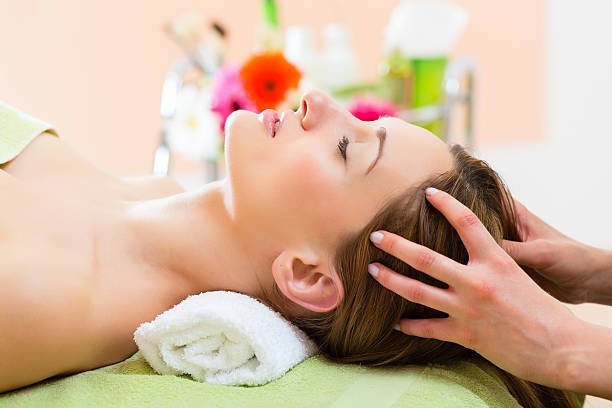
Shiro Abhyanga (Head Massage)
Shiro Abhyanga, a traditional Ayurvedic practice, involves a therapeutic head massage. It aims to promote relaxation, relieve stress, and enhance overall well-being by using gentle to firm strokes on the scalp, neck, and shoulders, often incorporating warm oils with soothing properties for a rejuvenating experience.
Shiro means ‘Head’ & Abhyanga means ‘Massage’. Thus, it means Ayurvedic head massage with herbal oils. Massaging the head & body is a very old Ayurvedic treatment for mental & physical ailments. Ayurvedic Shiro Abhyanga not only relaxes the mind & body but also keeps many diseases & stress away. It induces a sense of calmness, peace & tranquility. This daily head & body massage therapy helps the body to struggle through the busy schedules with a relaxed mind & soul. It gives longevity to the body cells & nerve tissues making the body flexible, healthy & immune.
- Rejuvenation: relaxing, calming and rejuvenating
- Beauty: hair nurturing
- Therapeutic: improves general wellbeing, reduces stress, reduces fatigue, improves clarity of mind, or as prescribed by the doctor.
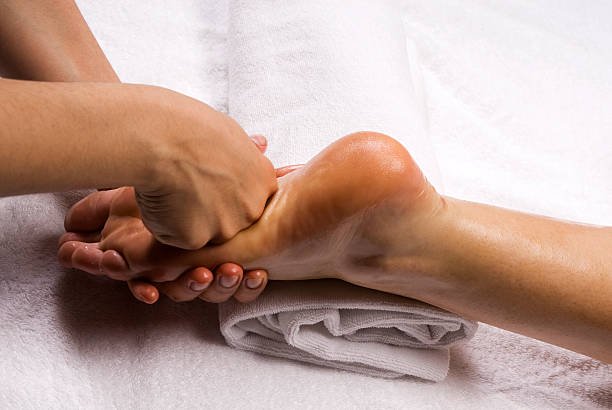
Pad Abhyanga (Foot Massage)
Pad Abhyanga, or foot massage, is a traditional Ayurvedic practice that involves massaging the feet with warm oil. It aims to relax the entire body, improve circulation, and balance energy. This therapeutic technique promotes overall well-being by soothing the nervous system and alleviating stress and fatigue.
Pad Abhyanga, or foot massage, is a therapeutic practice rooted in traditional Ayurvedic medicine, a holistic system that originated in India. This ancient technique focuses on promoting overall well-being by stimulating specific points on the feet, which are believed to correspond to various organs and systems in the body.
The term “Pad Abhyanga” combines “Pad” meaning foot and “Abhyanga” meaning massage with oil. This massage involves the application of warm herbal oils to the feet, creating a soothing and nourishing experience. The oils used in Pad Abhyanga are chosen based on individual constitution, or dosha, in Ayurvedic terms – Vata, Pitta, or Kapha. The massage itself incorporates gentle yet firm strokes, kneading, and pressure on specific points.
Pad Abhyanga offers numerous benefits. It helps improve blood circulation, promoting better oxygenation and nutrient supply to the body’s tissues. The massage can also induce relaxation, alleviate stress, and contribute to better sleep quality. Additionally, it is believed to balance the doshas, supporting overall harmony in the body and mind.
Regular practice of Pad Abhyanga is thought to enhance flexibility, reduce stiffness, and support the body’s natural healing processes. In Ayurveda, the feet are considered a vital part of the body’s energy system, and Pad Abhyanga is a way to nurture and maintain this essential aspect of well-being. This ancient foot massage is not only a physical therapy but also a holistic approach to holistic health and balance.
- Rejuvenation: relaxing and rejuvenating.
- Beauty: skin smoothening.
- Therapeutic: improves general wellbeing, reduces fatigue, reduces feet discomfort, reduces inflammation, stimulates blood circulation, or as prescribed by the doctor.

Diet Therapy
Diet therapy involves the therapeutic use of specific nutritional plans to prevent, manage, or treat health conditions. Tailored to individual needs, it aims to optimize overall well-being by addressing dietary imbalances. This approach emphasizes the crucial role of nutrition in promoting and maintaining health.
Diet therapy, also known as medical nutrition therapy, is a therapeutic approach that utilizes dietary interventions to manage and prevent various health conditions. It involves the personalized assessment and modification of an individual’s diet to optimize their nutritional status and support the treatment of specific medical conditions. The primary goal of diet therapy is to improve overall health, alleviate symptoms, and enhance the effectiveness of medical treatments.
In diet therapy, healthcare professionals, such as registered dietitians, work closely with patients to develop customized nutrition plans tailored to their unique needs and medical requirements. These plans consider factors such as the individual’s age, gender, medical history, lifestyle, and specific health goals. Diet therapy is commonly employed in the management of chronic diseases like diabetes, cardiovascular disorders, obesity, and gastrointestinal issues.
The interventions may include adjustments in caloric intake, nutrient distribution, and food choices. Specialized diets, such as low-sodium, low-fat, or high-fiber diets, may be prescribed based on the condition being addressed. Additionally, diet therapy plays a crucial role in promoting healthy eating habits, weight management, and disease prevention.
Diet therapy is an integral component of comprehensive healthcare, often complementing other medical treatments. It empowers individuals to take an active role in their health by making informed food choices that support their well-being. As a non-invasive and cost-effective approach, diet therapy contributes to the holistic care of individuals, emphasizing the significance of nutrition in maintaining and restoring health.
- Eliminative Diet: Liquids-Lemon, Citric juices, Tender Coconut water, Vegetable soups, Butter milk, Wheat Grass juices etc.
- Soothing Diet: Fruits, Salads, Boiled/Steamed Vegetables, Sprouts, Vegetable chutney etc.
- Fasting Diet: juice fasting, fruit fasting & raw diet fasting .
These ways of diet rotation helps us to detoxify & cleanse inner system of body which relevantly results as a cure to our health seekers. Being alkaline, these diets help in improving health, purifying the body and rendering it immune to disease. To this end, a proper combination of food is necessary.
